

Ready to get started?

Designed with a singular vision...To deliver unmatched performance and efficiency!
Introducing the insetta 35ifc – the bar has been raised.
The Insetta 35IFC was designed with a singular vision… to be the best-performing center console sport fishing catamaran in its class. Enjoy unmatched performance, range, and efficiency thanks to the 35IFC’s hydrofoil-assisted design.
In addition to being the best High-Performance Fishing Catamaran in its class, it also provides a smoother and dryer ride in the rough stuff!
This boat was designed for people who fish, by people who fish! From its integrated livewells to its cavernous coffin boxes, level open deck layout, massive insulated storage and so much more, this boat was designed for maximum range and fishability!
Here’s what our customers have to say: “Holy crap do I love my 35 IFC with the Merc 300 V8’s on the back. We ran her down to Key Largo the other day, snorkeled all day, got lunch at Shipwrecks Bar and Grill, and ran back. Cruised between 40 and 45 mph, mostly around 42. So smooth it’s nuts. Burned maaaayyybe 40 gallons for the whole day. As we cruised the dashboard was telling us between 1.7 and 1.8 mpg, but I’m pretty sure we cruised more than 40 miles and burned between 35 and 40 gallons, no more. So… suffice it to say that you guys have absolutely crushed it and changed the game here. Fantastic work”! – Alan, Hull #4
Check out our FAQ’s section below for more about the Insetta 35 with IFC!
Specifications
Length Overall
Maximum Beam
Maximum Draft
Fuel Capacity
Cruise Speed
Cruise Miles Per Gallon (MPG)
Over 850 miles*
Cruise Range
Standard Features
Standard “Insetta White” Gelcoat Molded in Diamond Non-Skid Tackle Storage Stbd Side Tackle Storage Port Side 19 Gallon Freshwater Washdown/Shower 5 x In Deck Storage Hatch 2 x In Deck Macerated Fish Boxes 625 Qt Insulated Coffin Box, Split Boxes Walk through Transom Access (Door Optional) Two 36 gallon Integrated Transom Livewells Fresh and Raw Water Washdown 34 Rod Holders (gunnels and coffin box) 7 Stainless Gemlux Pull-Up Cleats LED Navigation Lights Boarding Ladder
Recessed Stainless Bow Rail
Helm / Console
Fiberglass Hardtop with Powder Coated Aluminum Supports Tempered Safety Glass Enclosure for Console 6 Integral Rod Holders Built into Rear Support Molded Fiberglass Leaning Post with Rear Face Seating and cooler 3 Wide Helm Seats 6 S/S Cup Holders Storage Box and Rigging Tray on Rear Facing Seat Storage Drawers Under Helm Seats 165 Qt Leaning Post Ice Box Located Under Rear Face Seats
Base Upholstery
Equipment and Electronics
3 Part Internal Foil System
3 Pump Capacity Sea Chest with Dual Livewell Pumps & Raw Water Feed
4 1100 GPH Bilge Pumps (2 in Each Sponson)
Standard Capacities
490 gallon fuel capacity.
625 Qt Insulated Coffin Box with Divider
165 Qt Leaning Post Ice box
Dual 36 Gallon Livewells
19 Gallon Freshwater
Frequently Asked Questions
IFC is Insetta Boatwork's Internal Foiling System.
You can expect a significant increase in cruise speed; Improved handling and stability in rough conditions; Better acceleration; A boat that is less affected by increased payload; A 20-40% increase in fuel efficiency; and a 20-40% further cruise range! Additionally, the IFC technology will also provide a drier ride in choppy conditions and Provide for more responsiveness when turning at speed!
The system is a fixed setup, there is nothing to operate and there are zero moving parts.
The IFC Technology in effect smooths out rough seas by allowing the boat to run from wave crest to wave crest at a relatively smooth and stable attitude. The IFC System creates lift which help to in effect “Carry” the hull higher in the water. The system acts as a set of wings carrying the boat at speed, keeping the hull from having to follow each wave across its entire contour. In other words the surface of the waves have less effect on the hull as the IFC system is lifting the boat. Additionally, the aerodynamic lift created by the catamaran hulls creates even more lift at the bow of the boat, keeping the nose high and preventing the “slamming” or sneezing found in other catamaran hulls.
No, you don’t. The foils are flush mounted to the bottom of the keels of each sponson (as well as up in the tunnel.) At its centerline the main foil of the IFC system is only slightly lower than the keel line. The boat will easily load onto a standard catamaran trailer. There is no big contraption hanging way down under the boat.
Remember, the foils are INTERNAL to the tunnel. At its lowest point the main foil is only slightly lower than the hull and is higher than the props. Because of this the odds of striking the foils are extremely low. The boat is designed to be lifted by the foil. The structural integrity of the foil system is such that the weight of the boat could be supported many times over by the foil. As such, if you did somehow manage to strike the foil on something EXTREMELY SUBSTANTIAL, like a stone shoal, the likely outcome is that you may (in a very worst case scenario) bend or break a foil wing. If that were to happen, you could still operate the boat to port with the remaining foils. The IFC foils are made from a very high-grade stainless steel and designed to meet or exceed relevant guidelines for impact and strength.
As water travels through the tunnel and around the foil, a tremendous vortex is created. This force keeps most debris from being trapped in the tunnel or around the foil. Between the pressure of the air moving through the tunnel, and the vortex created in the water, the tunnel and foils will stay clean and clear.
The outboards of the 35 IFC are mounted on a slight outward angle to place the propellers properly to maximize the thrust and flow efficiency created as the water travels through the tunnel and around the foils. This mounting also helps the boat to lean into a corner, much like a monohull.
Firstly, we’d ask, “Why would you want to?” But the short answer is no. IFC is an integrated system that is integral to the design of the boat.
The short answer is that boats with technology similar to IFC have been in use for many years, but not in the recreational market. Commercial and Military applications are quite prevalent. The initial design of a hull and system like this is quite complex and can be cost prohibitive. We at Insetta feel the gains in efficiency, speed, range and ride quality far outweigh the initial design and build cost.
Upon deciding to build a foiling Cat, Insetta assembled a team of naval Architects and Marine Engineers to refine an existing and proven design. Using their own state of the art construction techniques, Insetta brought an application specific version to the fiberglass Center Console market.
Optional Features
Customizable Garmin or Simrad Electronics JL Audio 10 Speaker Stereo System Flush Mount Acrylic Helm Bow Shade Custom Gelcoat or Combination of Colors Deluxe Upholstery Third Center Livewell Under Rear Facing Seat 40 gallon Seadek Flooring or Flexiteek Decking Additional Gunnel Rod Holders (18 standard) Recessed Wireless Phone Chargers Swivel Base Rod Holders Outlets for Electric Reels Additional Drink Holders on Leaning Post, Coffin Box, Gunnels and Helm Forward/Rear/Side Spreader Lights T-Top Outrigger Bases/Poles Gemlux Electric Head With 19 Gallon Blackwater Holding Tank Freshwater Sink and Vanity Inside Console Underwater Lights Heavy Duty Dive Ladder LED Under Gunnel Lighting On-Board Battery Charger Windlass Custom Aluminum Trailer Cockpit Table/Bow Table
Why did Insetta Boatworks decide to build a boat with IFC?
For decades, Hydrofoil power boats have proven to be the most efficient craft for a variety of offshore operations.
While pursuing a B.S. in physics in 1960, Victor Insetta was employed doing anti-submarine research that utilized high speed Deep-V patrol boats equipped with hydrofoils. Their ability to pursue submarines at high speed, operate safely offshore, and, being foil borne: allowed their hull to run clear of the water avoiding direct hits from torpedoes. Decades later, Vic and his family rode comfortably on hydrofoil ferries in Italy, flying over white capped waves in the bay of Naples.
In 2017, The Insetta 45 was chosen to be the official chase boat of the America’s cup! Four 45’ Insetta’s catamarans were shipped to Bermuda to assist at various cup events. Sailboats, competing from several countries, were catamarans with hydrofoils ! The Insetta 45’s ran parallel to these “foiling sail cats” to assist with TV coverage. The sailing cats were traveling at speeds approaching 50 mph, 2 ½ times the wind speed . Efficient … you bet . They could also turn on a dime at over 40 mph…
It became obvious: that a foiling cat would make a great offshore outboard power boat… Many foil power boat designs in the past, had wide foils that stuck out the sides, increasing their beam and draft. It made them difficult to dock, and they couldn’t operate in shallow waters. Joel Shine (chief operating officer) of Insetta Boatworks found a catamaran design that had hydrofoils mounted in the tunnel, (that location between the tunnel walls actually improves their efficiency), and does not add to its draft. Further improvements could be added by using our ultra-light high strength infused composite construction.
Joel, Vic and our technical staff reviewed the foiling cat’s initial specifications and performance data, and then sea trialed two foiling cats with internal hydrofoils. Our staff includes a second physicist and pilot… Glen Dobbs. We are all active boaters and we determined we would build our version of a foiling outboard powered cat. We contacted a Naval architect, who designed several successful foiling power cats . He is now a member of our technical staff.
Our 35 “foiling cat” design has set the standard for Foil-Assisted Sportfishing boats. The hull, foils, materials, and engines are synergistically combined, to provide: unrivaled high-speed cruising efficiency , and provide safe offshore handling, with unimpeded shallow water operation, including beaching, without foils or props contacting the bottom.
Insetta 35IFC
The premier internal foiling catamaran.

Integrated 36 Gallon Livewells & 625 QT Coffin Box Standard
Designed to fish.

850+ Mile Range!

Best in Class MPG, Smoother/Dryer Ride!
Performance.
Click the button below to contact or email us for more info!
Latest News

The Foiling Press – February 2024
The Foiling Press – February 2024 – February was a busy month for…

The Foiling Press – January 2024
We kicked off the year with a full house here at Insetta Boatworks! Three beautiful 35IFC’s in…

The Foiling Press – December 2023
The Foiling Press – December 2023 – We’ve wrapped up an incredible year…

The Foiling Press – April 2024
The Foiling Press – April 2024 – April has been a month full…

The Foiling Press – March 2024
The Foiling Press – March 2024 – Spring is in the air and…
Get the Latest Insetta News!
- First Name *
- Last Name *
Share this page

Looking for our latest catalog?
PowerCat – Above the Waves
The art of catamaran building new defined.
Chart your own course and discover the limitless possibilities of the open waters with PowerCat. Renowned for our expert craftsmanship and visionary design, we engineer power catamarans that redefine performance, efficiency, and comfort.
PowerCat – Where Innovation Meets the Sea
Every PowerCat vessel is a testament to our commitment to innovation and our passion for the sea. Our Diesel, Electric, Hybrid, and Solar Catamarans can all be fitted with our groundbreaking Maritime Advanced Range System (M.A.R.S) – a hydrofoil assisted system that exemplifies our pioneering spirit.
From meticulous design to precision engineering, our range of PowerCats showcases a perfect balance of weight distribution, stability, and speed. Our boats are lightweight powerhouses, designed to be up to 50% lighter than their closest competitors. This results in extraordinary fuel efficiency and higher speeds, even with smaller engines.
At PowerCat, we believe that safety and comfort should never be compromised for performance. Every PowerCat is built with safety at its core, featuring isolated waterproof regions, advanced electronic management systems, and continuous motor monitoring. Our interiors offer unmatched comfort, providing a perfect space for relaxation, entertainment, and the creation of lasting memories.
Explore our range of models, such as the exceptional PowerCat 8 , and experience the PowerCat difference. Here, luxury meets efficiency, and the horizon is just the beginning. Embark on your next adventure with PowerCat. Sail beyond the ordinary.

Support our hydrofoil educational content for free when you purchase through links on our site. Learn more
[2023] Hydrofoil Catamaran: The Ultimate Guide to Foiling on Water
- November 1, 2023
- Hydrofoil Basics
Experience the thrill of flying above the water with a hydrofoil catamaran!
Are you ready to take your hydrofoil boarding to the next level? Look no further than the hydrofoil catamaran. In this comprehensive guide, we’ll dive deep into the world of hydrofoil catamarans, exploring their history, how they work, their benefits and drawbacks, and everything else you need to know to make an informed decision. So, buckle up and get ready to soar above the waves!
Table of Contents
Quick answer, quick tips and facts, how does a hydrofoil catamaran work, benefits of hydrofoil catamarans, drawbacks of hydrofoil catamarans, choosing the right hydrofoil catamaran, maintenance and care, recommended links, reference links.
A hydrofoil catamaran is a type of watercraft that combines the stability of a catamaran with the lift and speed of hydrofoils. It uses specially designed foils to lift the hulls out of the water, reducing drag and allowing for faster and smoother sailing. Hydrofoil catamarans are popular among sailors and water sports enthusiasts for their incredible speed, maneuverability, and thrilling foiling experience.
Shopping Links: Hydrofoil Catamarans on Amazon | Hydrofoil Catamarans on Walmart | Hydrofoil Catamarans on Etsy
- Hydrofoil catamarans can reach speeds of up to 40 knots (46 mph) or more, depending on the design and conditions.
- The foils on a hydrofoil catamaran can lift the hulls out of the water, reducing drag and allowing for a smoother and faster ride.
- Hydrofoil catamarans are used for various purposes, including racing, recreational sailing, and even transportation.
- Foiling on a hydrofoil catamaran requires some skill and practice, but it’s an exhilarating experience once you get the hang of it.
- Hydrofoil catamarans come in different sizes and designs, catering to different skill levels and preferences.
Hydrofoil catamarans have a fascinating history that dates back to the early 20th century. The concept of using hydrofoils to lift boats out of the water and reduce drag was first explored by Italian engineer Enrico Forlanini in the late 1800s. However, it wasn’t until the 1950s that hydrofoil technology started to gain traction in the boating world.
The first hydrofoil catamaran, known as the “Aquavion,” was developed by the French engineer René Guilbaud in the 1950s. This innovative design combined the stability of a catamaran with the lift of hydrofoils, revolutionizing the world of sailing. Since then, hydrofoil catamarans have evolved and become more advanced, offering incredible speed, maneuverability, and stability on the water.
A hydrofoil catamaran works by utilizing hydrofoils, which are wing-like structures mounted underneath the hulls of the boat. These foils generate lift as the boat gains speed, lifting the hulls out of the water and reducing drag. This lift allows the hydrofoil catamaran to achieve higher speeds and a smoother ride compared to traditional boats.
The hydrofoils on a catamaran are typically designed with a curved shape, similar to an airplane wing. This shape creates a pressure difference between the upper and lower surfaces of the foil, generating lift. The foils are usually adjustable, allowing the sailor to fine-tune the performance of the catamaran based on the sailing conditions.
To control the hydrofoil catamaran, sailors use a combination of steering and sail trim. By adjusting the angle of the foils and the sails, they can optimize the lift and balance of the boat, ensuring a stable and efficient ride. It takes some practice to master the art of foiling on a hydrofoil catamaran, but the rewards are well worth the effort.
Hydrofoil catamarans offer a range of benefits that make them a popular choice among sailors and water sports enthusiasts. Here are some of the key advantages of hydrofoil catamarans:
Speed : Hydrofoil catamarans are known for their incredible speed. By lifting the hulls out of the water, hydrofoils reduce drag and allow the boat to glide smoothly above the waves. This enables hydrofoil catamarans to reach impressive speeds, making them a thrilling choice for racing and high-performance sailing.
Maneuverability : The lift generated by hydrofoils enhances the maneuverability of catamarans. With reduced drag, hydrofoil catamarans can make sharp turns and quick maneuvers with ease. This agility is particularly useful in racing scenarios, where every second counts.
Stability : The dual-hull design of catamarans provides inherent stability, even at high speeds. When combined with hydrofoils, the stability of hydrofoil catamarans is further enhanced. This stability makes them suitable for sailors of all skill levels, from beginners to experienced professionals.
Efficiency : Hydrofoil catamarans are more efficient than traditional boats. By reducing drag, hydrofoils allow the boat to sail faster while using less power. This increased efficiency translates to longer sailing distances and reduced fuel consumption, making hydrofoil catamarans an environmentally friendly choice.
Versatility : Hydrofoil catamarans are versatile watercraft that can be used for various purposes. Whether you’re looking for a high-performance racing catamaran or a recreational sailboat for family outings, there’s a hydrofoil catamaran to suit your needs. Some models even offer the option to switch between foiling and non-foiling modes, providing flexibility on the water.
While hydrofoil catamarans offer numerous benefits, it’s important to consider their drawbacks as well. Here are a few potential downsides to keep in mind:
Cost : Hydrofoil catamarans tend to be more expensive than traditional boats. The advanced technology and materials used in their construction contribute to the higher price tag. Additionally, maintenance and repairs can also be costly, especially if specialized parts or services are required.
Learning Curve : Foiling on a hydrofoil catamaran requires some skill and practice. It can take time to learn how to control the boat effectively and maintain stability while flying above the water. Beginners may find the learning curve steep, but with dedication and proper instruction, anyone can master the art of hydrofoil catamaran sailing.
Weather Conditions : Hydrofoil catamarans are sensitive to weather conditions. While they excel in flat water and moderate winds, rough seas and strong gusts can pose challenges. It’s important to be aware of the weather forecast and choose suitable sailing conditions to ensure a safe and enjoyable experience.
Transportation and Storage : Hydrofoil catamarans can be larger and bulkier than traditional boats, making transportation and storage more challenging. Specialized trailers or racks may be required to transport the catamaran, and adequate storage space is needed to protect it when not in use.
Despite these drawbacks, the thrill and excitement of foiling on a hydrofoil catamaran outweigh the challenges for many sailing enthusiasts.
When it comes to choosing the right hydrofoil catamaran, there are several factors to consider. Here are some key points to keep in mind:
Skill Level : Consider your skill level and experience as a sailor. Some hydrofoil catamarans are designed for advanced sailors, while others are more beginner-friendly. Choose a catamaran that matches your skill level to ensure a safe and enjoyable sailing experience.
Intended Use : Determine how you plan to use the hydrofoil catamaran. Are you looking for a racing catamaran, a recreational sailboat, or something in between? Different models offer varying features and performance characteristics, so it’s essential to choose a catamaran that aligns with your intended use.
Budget : Set a budget for your hydrofoil catamaran purchase. Prices can vary significantly depending on the brand, model, and features. Consider both the upfront cost and the long-term maintenance expenses when determining your budget.
Brand and Reputation : Research different brands and their reputation in the hydrofoil catamaran industry. Look for brands with a track record of producing high-quality, reliable catamarans. Reading customer reviews and seeking recommendations from experienced sailors can also provide valuable insights.
Demo and Test Sails : Whenever possible, try out different hydrofoil catamarans before making a final decision. Many manufacturers and dealers offer demo and test sails, allowing you to experience the performance and handling of the catamaran firsthand. This hands-on experience can help you make an informed choice.
Remember, choosing the right hydrofoil catamaran is a personal decision that depends on your individual preferences and needs. Take your time, do your research, and consult with experts to find the perfect catamaran for your hydrofoil adventures.
Proper maintenance and care are essential to keep your hydrofoil catamaran in top shape and ensure its longevity. Here are some maintenance tips to help you keep your catamaran performing at its best:
Rinse with Fresh Water : After each sailing session, rinse your hydrofoil catamaran with fresh water to remove salt and debris. Pay special attention to the foils, as saltwater can cause corrosion over time.
Inspect for Damage : Regularly inspect your catamaran for any signs of damage or wear. Check the foils, hulls, rigging, and sails for any cracks, dents, or loose fittings. Address any issues promptly to prevent further damage.
Store Properly : When not in use, store your hydrofoil catamaran in a dry and secure location. If possible, keep it covered to protect it from the elements. Consider using a boat cover or storing it in a boat shed or garage.
Follow Manufacturer’s Guidelines : Follow the manufacturer’s guidelines for maintenance and care. Each catamaran may have specific recommendations for cleaning, lubrication, and other maintenance tasks. Adhering to these guidelines will help prolong the life of your catamaran.
Seek Professional Assistance : If you’re unsure about any maintenance tasks or need assistance, don’t hesitate to seek professional help. Local boatyards, sailing clubs, or authorized dealers can provide expert advice and services to keep your catamaran in optimal condition.
By following these maintenance tips and caring for your hydrofoil catamaran, you can enjoy many years of thrilling foiling adventures on the water.
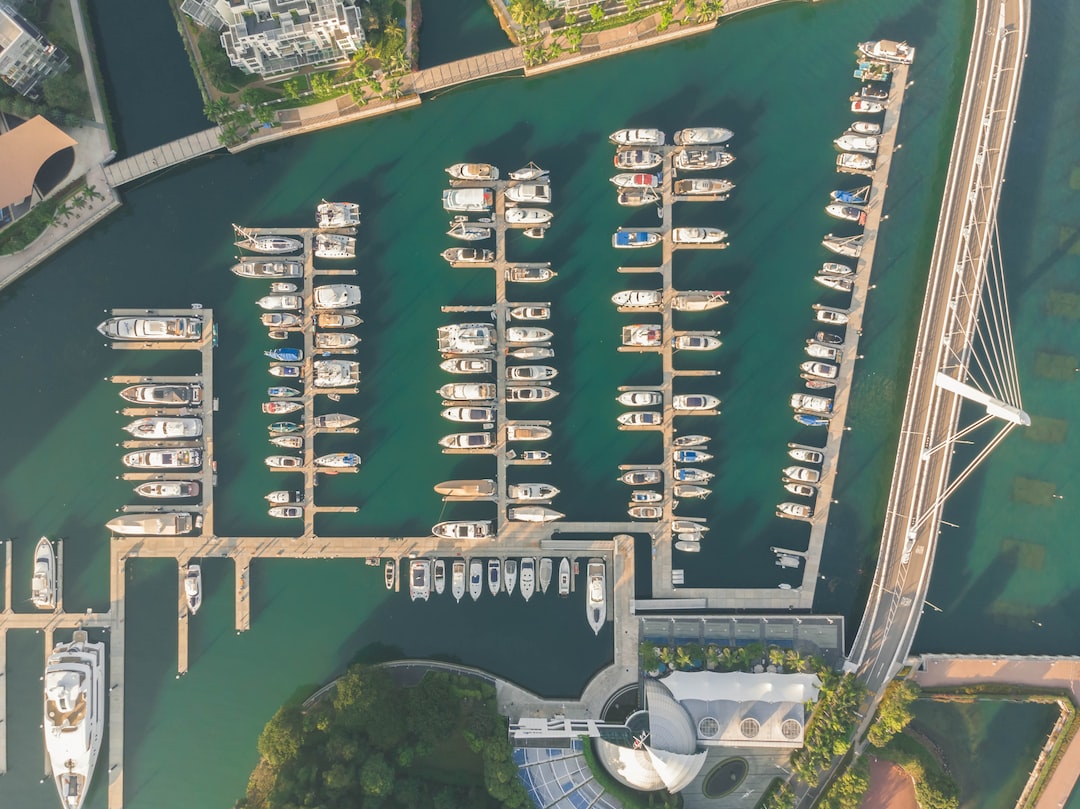
How fast is the hydrofoil catamaran?
Hydrofoil catamarans can reach impressive speeds, depending on various factors such as the design, wind conditions, and skill of the sailor. Some high-performance hydrofoil catamarans can exceed 40 knots (46 mph) or more. However, the exact speed will vary based on these factors.
How does a foil catamaran work?
A foil catamaran, also known as a hydrofoil catamaran, works by utilizing hydrofoils to lift the hulls out of the water. These foils generate lift as the boat gains speed, reducing drag and allowing for faster and smoother sailing. The lift created by the foils enables the catamaran to “fly” above the water, resulting in increased speed and improved performance.
What happened to hydrofoils?
Hydrofoils have a rich history and have been used in various applications, including passenger ferries, military vessels, and recreational boats. While hydrofoils experienced a surge in popularity in the mid-20th century, their use declined in some sectors due to factors such as high costs, maintenance challenges, and the development of alternative technologies. However, hydrofoils continue to be used in niche markets, including high-performance sailing and racing.
Read more about “… What is the World’s Largest Hydrofoil Boat?”
Are hydrofoil boats more efficient?
Yes, hydrofoil boats are generally more efficient than traditional boats. By lifting the hulls out of the water, hydrofoils reduce drag and allow the boat to sail faster while using less power. This increased efficiency translates to longer sailing distances and reduced fuel consumption. However, it’s important to note that the efficiency gains may vary depending on factors such as the design, sailing conditions, and skill of the sailor.
Hydrofoil catamarans offer an exhilarating and thrilling experience on the water. With their incredible speed, maneuverability, and stability, they have become a favorite among sailors and water sports enthusiasts. While they may come with a higher price tag and require some skill to master, the rewards of foiling on a hydrofoil catamaran are well worth it.
When choosing a hydrofoil catamaran, consider factors such as your skill level, intended use, budget, and the reputation of the brand. Take the time to research and test different models to find the perfect catamaran for your needs.
So, are you ready to take flight on a hydrofoil catamaran? Embrace the thrill, experience the freedom, and enjoy the incredible sensation of soaring above the water. Happy foiling!
- Hydrofoil History
- Advanced Hydrofoiling Techniques
- Hydrofoil Equipment Reviews
- Why do boats not use hydrofoils?
- iFLY15 – iFLY Razzor Pro – Foiling Catamaran
- Hydrofoil Catamarans on Amazon
- Hydrofoil Catamarans on Walmart
- Hydrofoil Catamarans on Etsy
Review Team
The Popular Brands Review Team is a collective of seasoned professionals boasting an extensive and varied portfolio in the field of product evaluation. Composed of experts with specialties across a myriad of industries, the team’s collective experience spans across numerous decades, allowing them a unique depth and breadth of understanding when it comes to reviewing different brands and products.
Leaders in their respective fields, the team's expertise ranges from technology and electronics to fashion, luxury goods, outdoor and sports equipment, and even food and beverages. Their years of dedication and acute understanding of their sectors have given them an uncanny ability to discern the most subtle nuances of product design, functionality, and overall quality.
Related Posts
Does foil surfing have a motor [2024] 🏄♂️.
- May 2, 2024
Can You Foil Surf in Flat Water? [2024] 🏄♂️
Catch the wave: the ultimate beginner’s guide to prone foil boarding [2024] 🌊.
- April 28, 2024
Leave a Reply Cancel Reply
Your email address will not be published. Required fields are marked *
Add Comment *
Save my name, email, and website in this browser for the next time I comment.
Post Comment
Trending now

- THE PRINCESS PASSPORT
- Email Newsletter
- Yacht Walkthroughs
- Destinations
- Electronics
- Boating Safety

The Power Catamaran Compilation
- By Yachting Staff
- Updated: December 21, 2018
Power Catamarans have been growing leaps and bounds in popularity, and, in lengths and widths. And for good reason. These cruise-centric yachts offer homelike livability for avid travelers, are fuel efficient and are fairly intuitive to run. Power cats are popular in the bareboat charter market too, for these very reasons.
Here, we take a look at 12 catamarans ranging from a cruising-couple-size 36-footer to a 78-footer for friends, family and some more friends. And there are myriad power options: outboards, diesel inboards, hybrid or even all-solar power.
Fountaine Pajot MY44
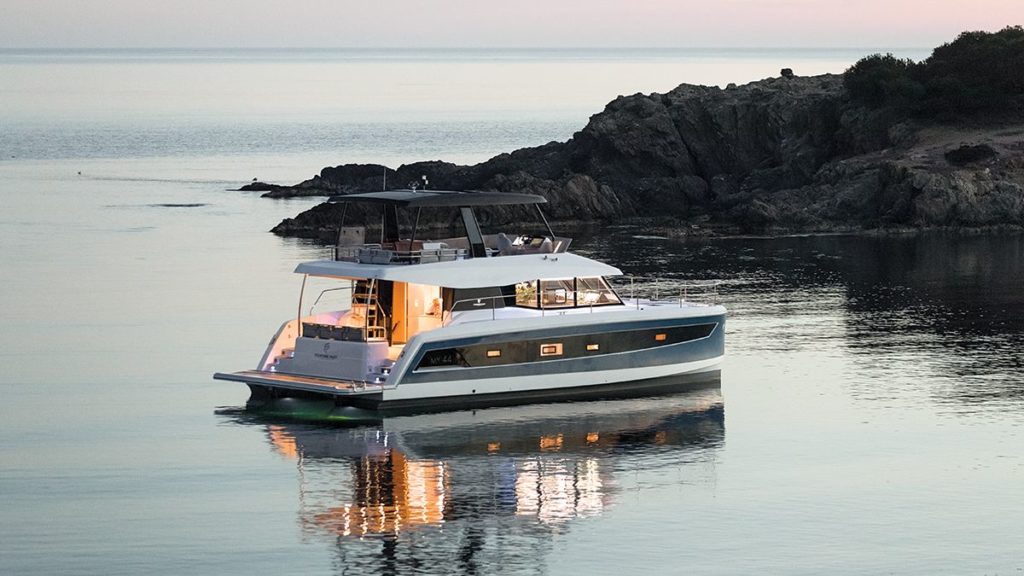
The Fountaine Pajot MY44 , a creation of Italian architect Pierangelo Andreani and French designer Daniel Andrieu, has a main deck that’s open from the aft-deck seating all the way forward to the starboard helm station. The sense of spaciousness is significant, for several reasons. First, four glass panels aft can all slide to port, creating an indoor-outdoor space with the aft deck and salon. In the salon, 32-inch-high windows extend for 12 feet down the sides of the yacht, with three sections per side, bringing in natural light along with the three forward panes that comprise the windshield. Finally, 6-foot-6-inch headroom provides vertical clearance, with a 21-foot-7-inch beam that adds interior roominess while keeping the yacht stable.
Read more: Fountaine Pajot MY44
Silent-Yachts 55
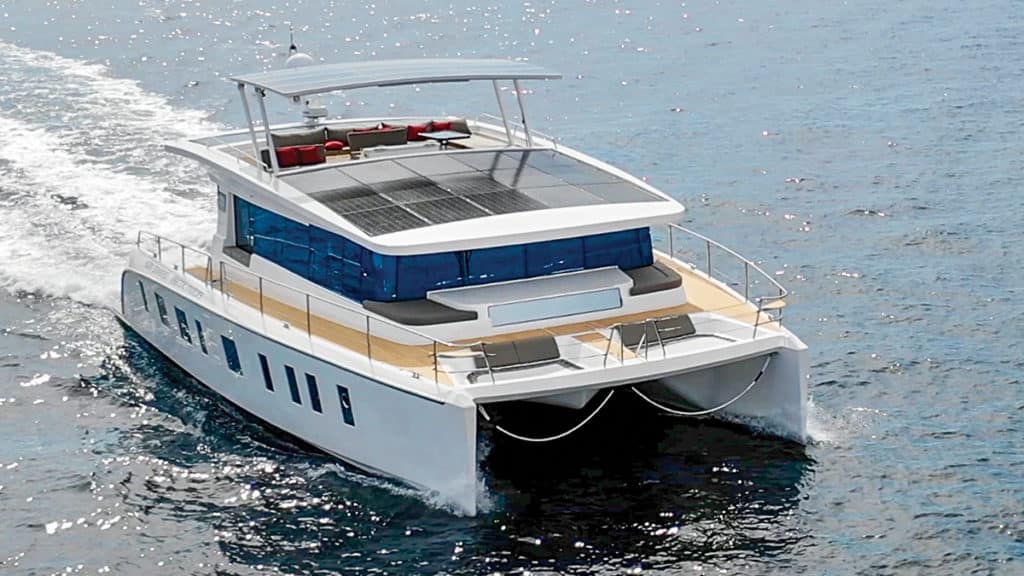
The ideas about which solar panels, electric motors, inverters and the like to use — and more importantly, Michael Köhler says, how to configure them — became the basis for the brand Silent-Yachts. The company offers 55-, 64- and 79-foot catamarans that run on solar-electric propulsion. The Silent 55 premiered this fall, and the 64 is sold out for the next two years, Köhler says.
Read more: Silent 55
Horizon PC74
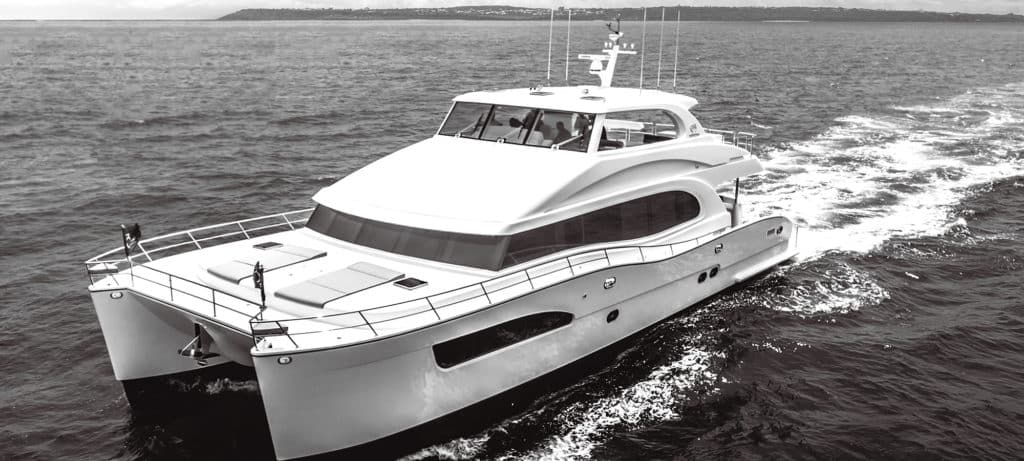
As founder and director of The Powercat Company, a Horizon Power Catamarans distributor, Stuart Hegerstrom had long believed that catamaran builders needed to design their yachts to more stylish standards.
“The boats were very boxy,” he says, based on his years of experience with cats in the charter market. He and his partner, Richard Ford, asked Horizon to produce models that had high-end finishes and looked good inside and out.
The Horizon team brought in mega-yacht designer JC Espinosa to work with its own craftsmen. The result aboard the Horizon PC74 is a catamaran with exterior styling, layout and functionality that should appeal to private and charter owners alike.
Read more: Horizon PC74
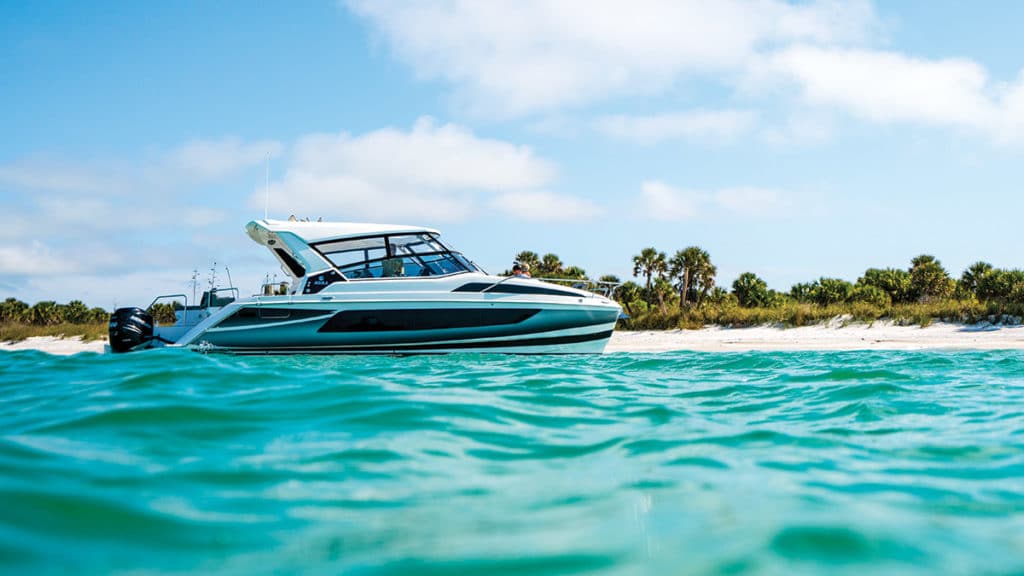
The Aquila 36 is a departure from her sisterships in that she is an outboard-powered, express-cruiser-style catamaran, but she also adheres to MarineMax’s philosophies.
With a single main living level from bow to stern and a beam of 14 feet 7 inches, the Aquila 36 is like a bowrider on steroids. She has seating that can handle 20 adults for outings and barbecues, and there are two staterooms below, one in each hull, for family weekending. The staterooms have nearly queen-size berths, en suite heads, stowage and 6-foot-6-inch headroom.
Read more: Aquila 36
Lagoon Seventy 8 Powercat
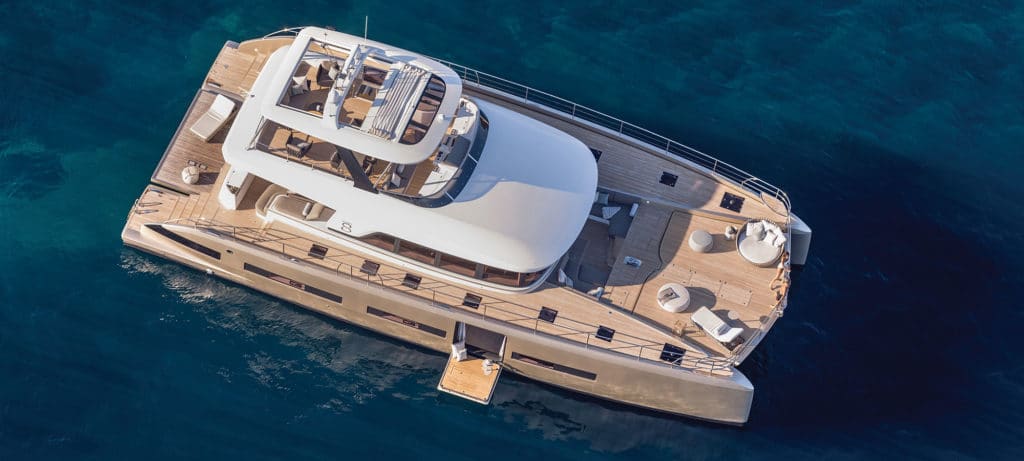
Lagoon is a division of Groupe Beneteau, the world’s largest builder of sailing yachts, and the Lagoon Seventy 8 Powercat is a developmental sistership of its Seventy 7 super sailing cat. The Seventy series yachts are built at Construction Navale Bordeaux in France, which had to add a new yard to construct these catamarans because they require separate stern molds for the power and sail versions.
Read more: Lagoon Seventy 8 Powercat
Horizon PC60
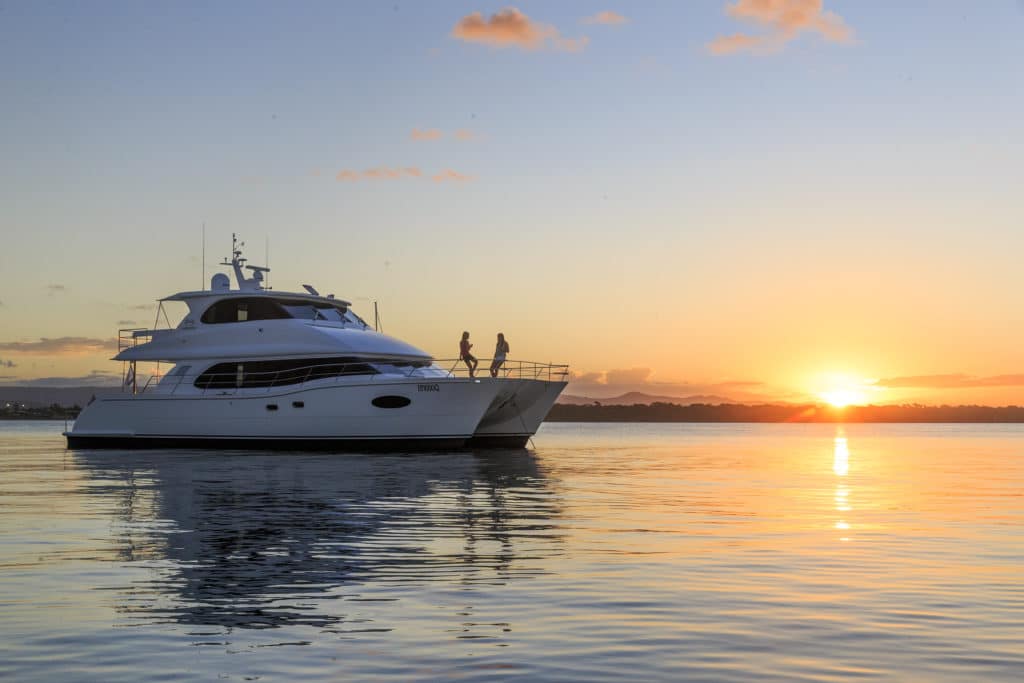
To understand the Horizon PC60 power catamaran , you need to put aside preconceived notions about midsize yacht amenities. For example, main-deck master suites are the province of yachts over 100 feet length overall. Incorrect. This 60-footer has an elegant and spacious owner’s stateroom on the same level as the salon. If you want a 14-foot center console tender on a 60-foot yacht, you have to tow it. Wrong again. On the PC60, you hoist it onto the upper deck, no problem.
Read more: Horizon PC60
40 Open Sunreef Power
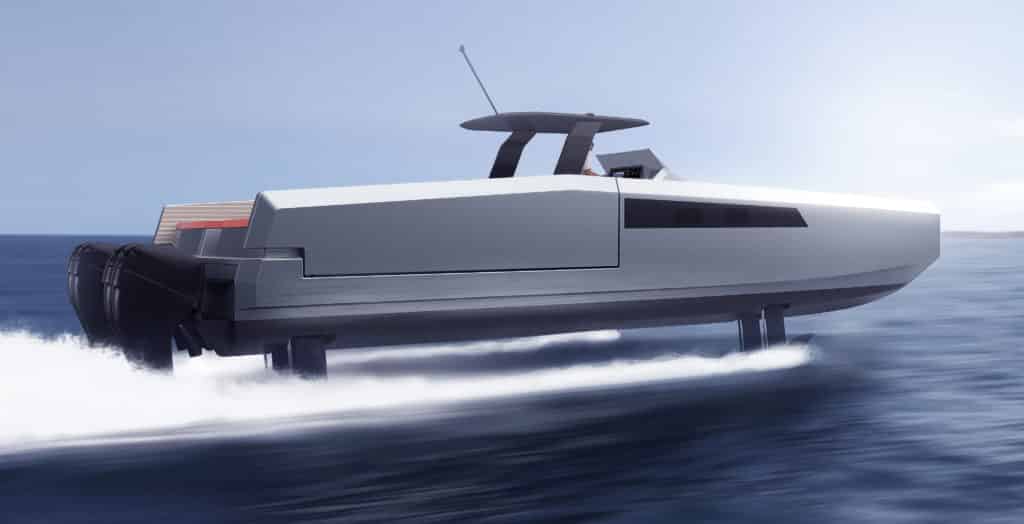
Sunreef is known for pushing the boundaries of catamaran design, incorporating four adjustable hydrofoils into a twin-hulled speedboat.
The Polish builder is one of several European builders (including Evo, Fjord, Wider and Wally) transforming the open day-boat category with creative designs. Beyond its hydrofoils, the 40 Open Sunreef Power ‘s cockpit has side “wings” along the aft gunwales that fold out at anchor, widening the beam from 17 feet to 22 feet 9 inches.
Read more: 40 Open Sunreef Power
Sunreef 50 Amber Limited Edition
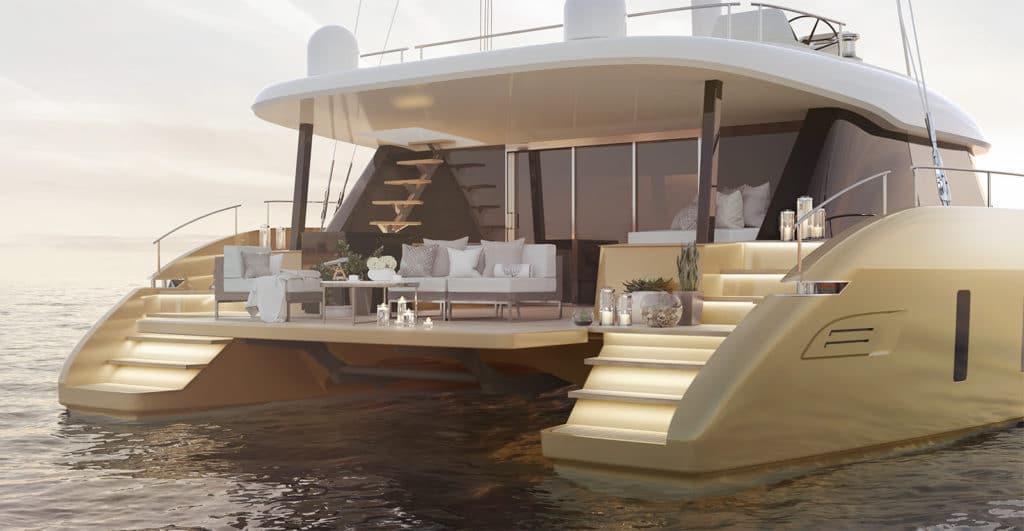
Sunreef Yachts introduced its 50 Amber Limited Edition , with plans to launch just 10 hulls of the exclusive design.
The Sunreef 50 Amber Limited Edition will have a carbon fiber mast and boom, four layout options and numerous amber-colored elements, including the hull.
Read more: Sunreef 50 Amber Limited Edition
Lagoon 630 Motor Yacht
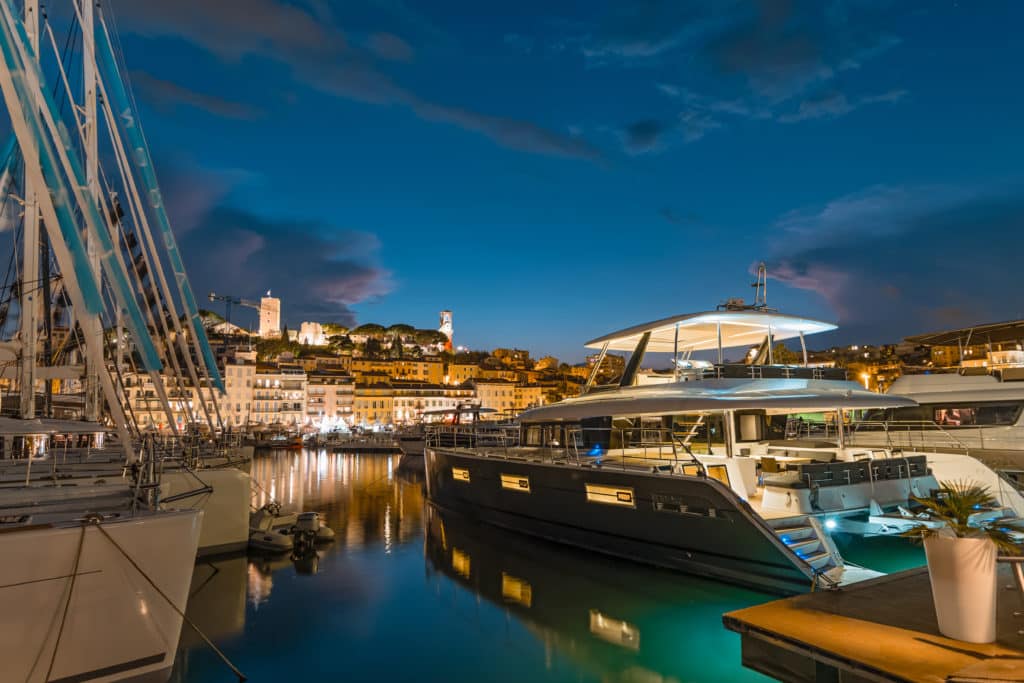
Fitted with the optional twin 300-horsepower Volvo Penta D4 diesels, the Lagoon 630 MY burns only 1.64 gph total at 6 knots, giving a theoretical range of 2,952 nautical miles with standard tankage of 793 gallons. Hull No. 1 had an optional 502-gallon tank, giving it transatlantic range.
Luxury, stability and economy are all hallmarks of Lagoon’s return to luxury motor yachts. If you can take a ride, it will be worth your time.
Read more: Lagoon 630 Motor Yacht
Fountaine Pajot MY 37
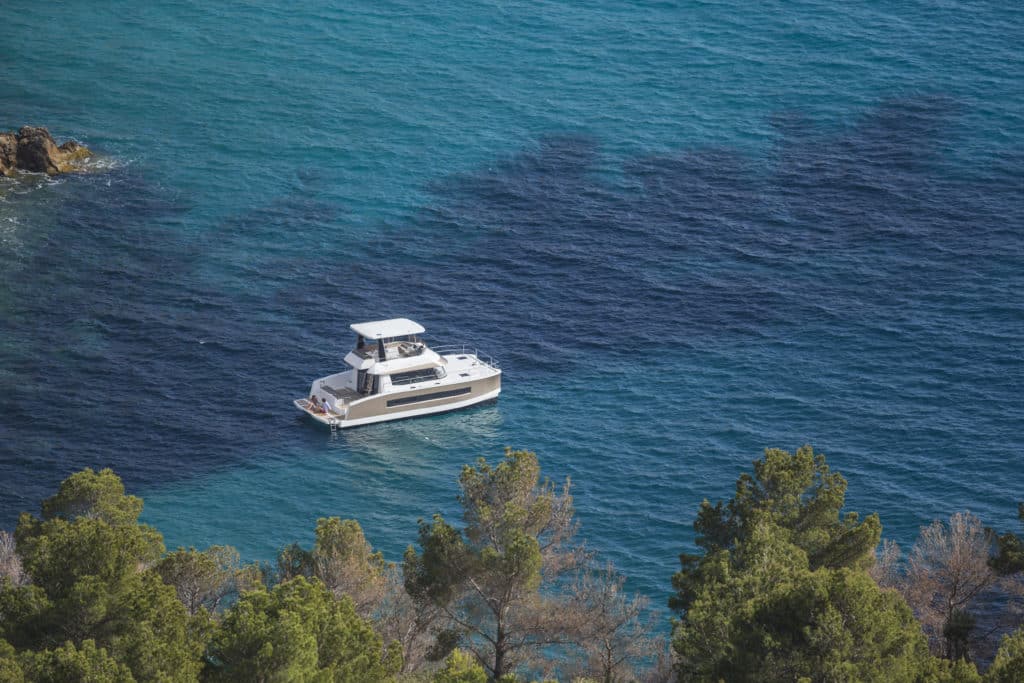
The Fountaine Pajot MY 37 easily accommodates the seafaring family with three- and four-stateroom options. In the three-cabin version, called Maestro, you’ll find an owner’s suite in the portside hull with a queen-size berth and en suite head. Two double-berth cabins and one more head are available for the kids. If your brood is bigger, the Quator setup features four double cabins with two heads.
The 37 is a traveler and can be powered with twin 150 hp or 220 hp Volvo Penta diesels. Top speed with the smaller engines is 17 knots, while it’s 20 knots with the bigger power plants. Interestingly, at 7 knots, the fuel consumption is the same, with either set of motors offering voyagers a 1 ,000-nm range.
Read more: Fountaine Pajot MY 37
Solarwave 64
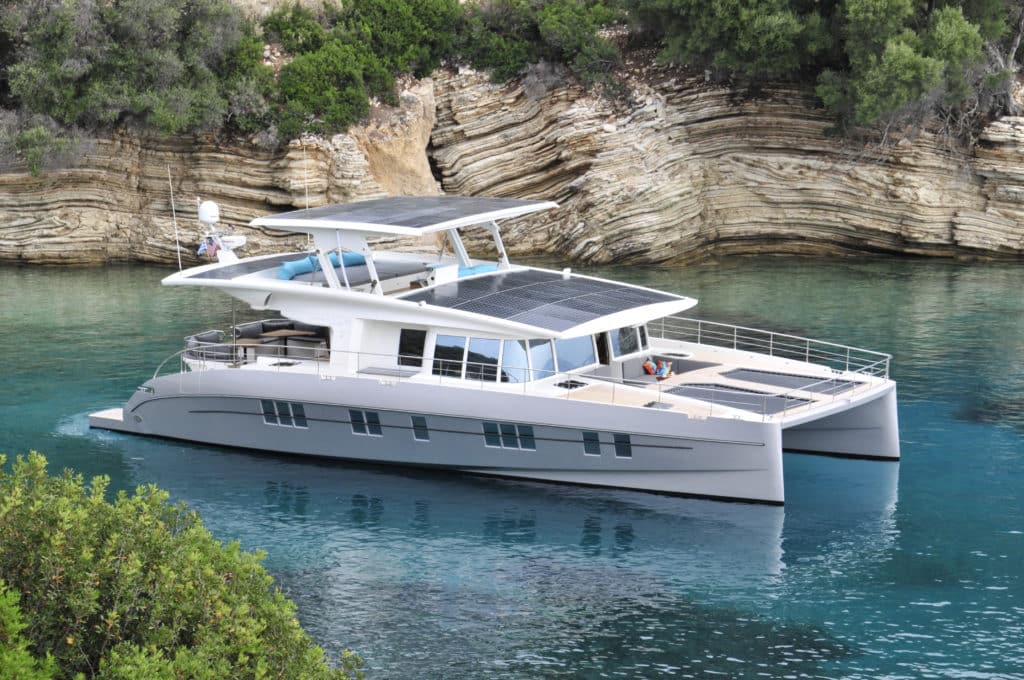
Many yachts boast eco chops because they have a handful of solar panels that power the microwave or navigation lights. The Solarwave 64 , launched last summer, has the potential to run on sunshine alone. The vessel’s 42 solar panels generate 15 kW that are stored in batteries weighing about 1,300 pounds. They connect to electric motors.
Read more: Solarwave 64
Glider SS18
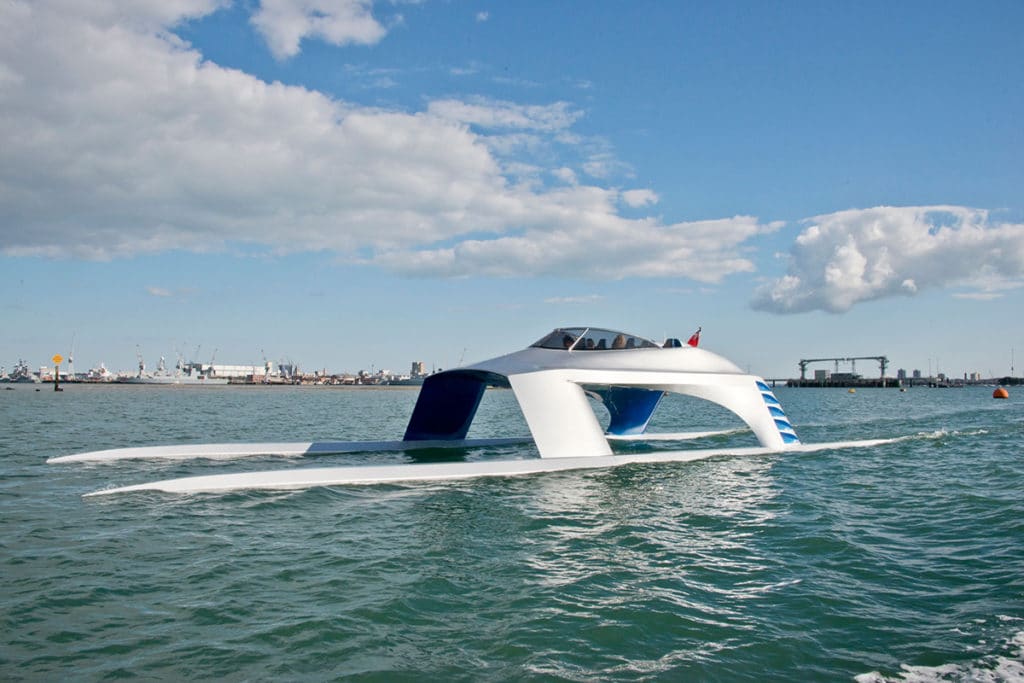
This British builder says it strives for design innovation and the Glider SS18 displays that DNA, the result of 8 years of research and development. She has a head-turning, catamaran hull form constructed from aluminum and composite materials. She is 60 feet LOA with a 17-foot beam, and has a relatively shallow 1-foot draft. Powered by quad Yamaha 300 hp outboards, she can reportedly reach 50 knots, and with her Stability Control System (SCS), should give a smooth ride while doing it.
Read more: Glider SS18
- More: aquila , Aquila Boats , Express and Flybridge Cruisers , Fountain Pajot , Glider Yachts , Horizon Power Catamarans , Lagoon , Power Catamarans , Silent-Yachts , Sunreef , Yachts
- More Yachts
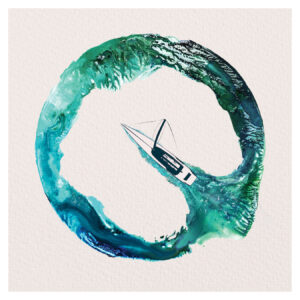
Royal Huisman to Build 264-Foot “Noir”
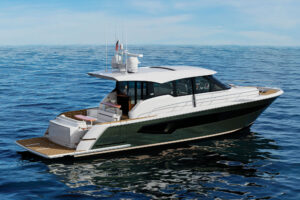
Tiara Yachts EX 54 Expands Series
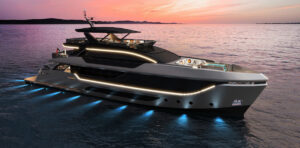
Van der Valk’s Biggest Motoryacht Yet
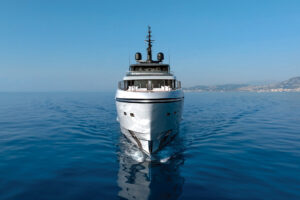
Sanlorenzo 57Steel Reviewed
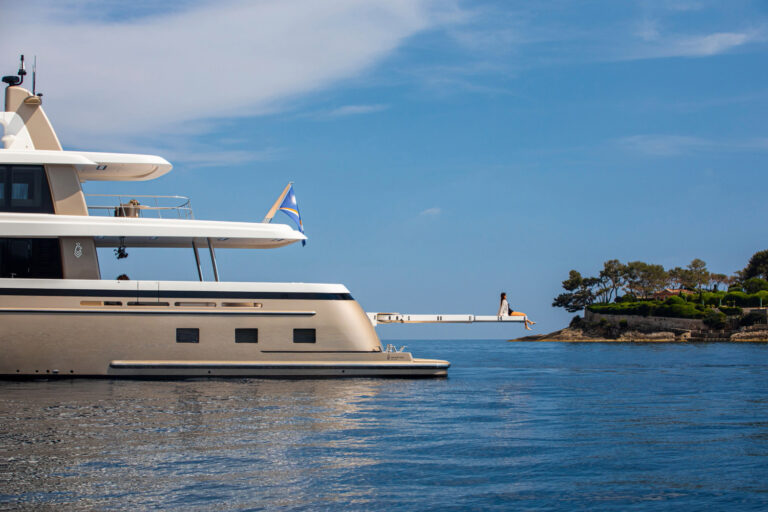
Your World, Your Yacht
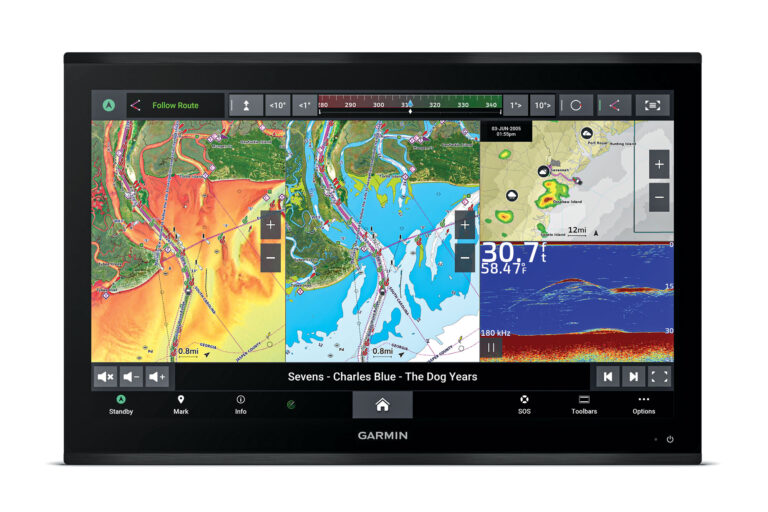
Garmin GPSMap 9000 Series MFD
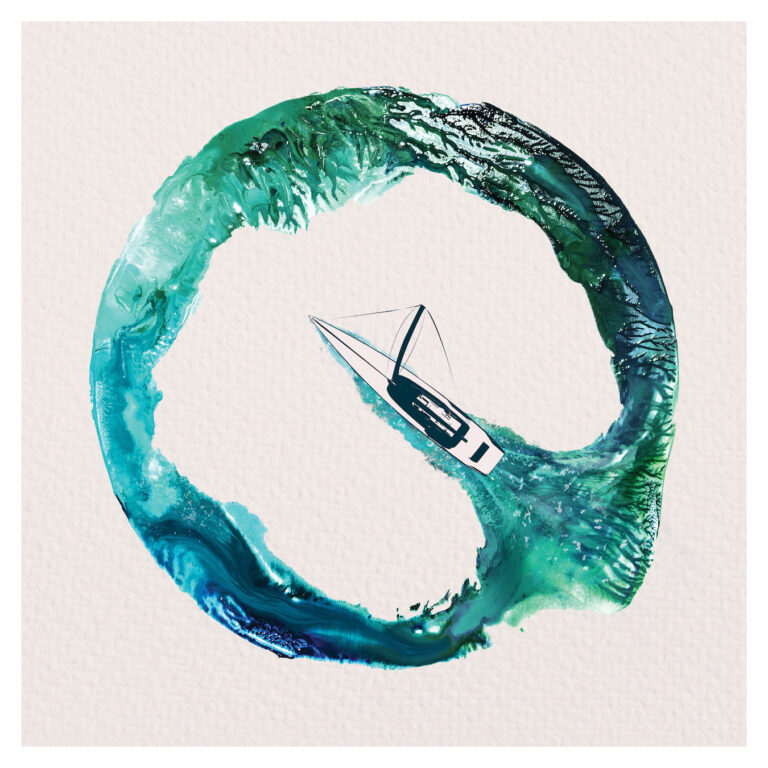
For Sale: Offshore 62

- Digital Edition
- Customer Service
- Privacy Policy
- Email Newsletters
- Cruising World
- Sailing World
- Salt Water Sportsman
- Sport Fishing
- Wakeboarding

- (321) 878-3645
Welcome to Tarpon River Boatworks
About Us – Our Story
Experience driven innovation meets real-world boating challenges.
Designed for the boating enthusiast who only want the best experience on the water.
Engineering
Engineered to reduce fatigue, increase range, and decrease fuel consumption.
25 Years in the Making
Tarpon River Boatworks
Tarpon River Boatworks was forged from 25+ years of experience in the marine industry. Our founder and CEO, Todd Meyer, started his path to becoming a seasoned waterman as a child who spent extensive time on the water with his father. From there, Todd built a long career in the marine industry that extended to the absolute pinnacle in Grand Prix Yachting regattas around the world. In 2014, Todd decided it was time to shift his focus from running boats and managing fleets to building a ”better boat”…
years of abuse at the hands of rough seas, long days on the water and rigid designs set him on a quest that led to the founding of Tarpon River Boatworks. Having spent the previous 15 years running nearly all manner of watercraft, from small RHIBs to large center consoles, his mission picked up momentum when he first experienced driving a large power catamaran and quickly realized its merits. Although the ride was closer to what he had envisioned it still lacked the magic Todd was seeking to bring to the marine industry…
Inspiration becomes a Mission then a Partnership
It was on a kitesurfing outing in which Todd was using a hydrofoil that gave him the smooth ride he was seeking from within the boating world. Todd’s mission was now clear, develop and launch an unrivaled hydrofoil-assisted, power catamaran. Utilizing his tier-one experience and extensive network with the top naval architects and designers around the globe, he decided the right team for the project was Morrelli & Melvin Design and Engineering.
Starting with a 24 foot prototype, they honed the platform and are now setting the new standard in power catamarans starting with fully customizable 25’ and 33.5′ platforms. Todd and his team are excited to bring this unique boating experience to the water. We look forward to you joining us on our voyage.

Professional BoatBuilder Magazine
The efficiency of a foiling powercat.
By Dieter Loibner , Mar 13, 2020

Matanzas Watercraft’s founder, Jan Brandt, in his office with a rendering on the wall and the prototype of the Matanzas 29 foiling powercat peeking through the shop door.
Motivated by his own boating experience and America’s Cup foiling technology, a startup builder launches the Matanzas 29, a new breed of powercat for fishing and cruising.
Wherever Jan Brandt goes, a constant companion since his childhood days in Hamburg, Germany, is his passion for watersports. Competitive swimming, surfing, waterskiing, fishing, scuba diving, sailing, you name it, he’s done it—and still does. No surprise, then, that Brandt is also deeply involved with boats, not just using them but also designing and building them. His latest project is a 29 ‘ (8.8m) foil-assisted planing cruising power catamaran designed for twin outboards from 60 hp to 90 hp. Last fall, construction was far advanced as Brandt prepped for finishing, outfitting, and getting the boat ready for sea trials off St. Augustine, Florida, where he set up shop as Matanzas Watercraft LLC.
Inspired by the Sliver 29, a catamaran designed for fishing and weekending, built by SuperCat in South Africa , Brandt defined specifications that suited his own use patterns and his home port in St. Augustine. “I am looking to build a day-use cat for fishing offshore waters but also capable enough to make the run to Bimini and Abacos on a calm summer morning,” his design brief reads. Also on the list: sufficient load capacity for three to four people for day use and provisions for a couple to cruise for a few days; a range of 200 nm on one tank; and a cruising speed of 20 to 25 knots. Brandt: “I need to deal with a 2–3 ‘ [0.6m–0.9m] chop and Atlantic Ocean swells. While an open cockpit with center console and hardtop is totally sufficient, a head and dry storage for gear with maybe just enough space for a bunk for two would be awesome.” Since crab or lobster pot buoys are not much of a concern in Florida, Brandt explored the idea of foil assist to reduce power requirements and improve seakeeping. However, he was adamant about the ability to safely beach the cat and limit overall beam to 9.1 ‘ (3m) to keep the trailering permits manageable.

The Matanzas 29 plywood/carbon prototype has wave-piercing bows with a positive rake and peaked decks that shed water quickly. The bows’ fine entry flattens out toward the stern to encourage planing, even when operating without foils.
He did some preliminary design work himself, but when the project got serious he consulted with Bieker Boats of Anacortes, Washington. Principal Paul Bieker served as the lead designer of the Oracle America ’s Cup sailing team and was instrumental in developing the outrageously fast 72 ‘ (22m) foiling catamarans that ushered in a foiling revolution following the 2013 Cup on San Francisco Bay. Bieker now applies variations of the foiling concept to pleasure craft, most recently with an innovative 53 ‘ (16m) sailing catamaran intended for racing and weekend cruising (see “ Fledging the Eagle ,” Professional BoatBuilder No. 182) and now with Brandt’s foiling powercat.
The basic idea behind foiling is maximizing efficiency while curbing the need for big engines, a notion that has yet to find footing with production boatbuilders. Brandt: “I’m not interested in boats over 25 ‘ [7.6 m] running 250- or 300-hp twin motors. I’ve been doodling around for a year on the idea, spent more time on the hullform, and when I decided to pull the trigger on building one, that’s when I contacted Paul to help me finalize the design, incorporate some of the design criteria and requirements, and make it work from an engineering perspective. He helped crystallize the hull shape and get the details fleshed out.”
Foiling Tech Trickle-Down
A former racing sailor who campaigned a Mini 650, Brandt met Bieker in 2010 while cruising the waters of Puget Sound. He ran his own environmental consulting firm in Seattle and also took up boatbuilding. First came stitch-and-glue kayaks, but soon he graduated to the PT Skiff, an 18′ (5.5m) kit boat by Port Townsend Watercraft designed by Bieker and Russell Brown. With Brown’s encouragement Brandt designed and built the cedar-strip carbon composite Syhoya , a handsome 21 ‘ (6.4m) weekend cruiser powered by a 60-hp Evinrude E-Tec outboard for cruising Puget Sound and beyond.

Previously, Brandt designed and built Syhoya, a 21’ (6.4m) weekender with a 60-hp outboard for cruising the coastal waters of the Pacific Northwest.
In Brandt’s painstakingly clean and organized workshop a 10-minute drive from his house in St. Augustine Beach, Bieker’s plans laid out on the workbench and the prototype of the Matanzas 29 under construction showed how personal predilection, boating experience, and exposure to innovative design ideas informed his choices. For a simple boat that aims to maximize efficiency and minimize power requirements, the design process was complicated. Some salient features, like the combination of planing hulls with wave-piercing bows and the foil arrangement most commonly associated with fast sailing cats, seem a bit counterintuitive at first, but Brandt explained the underlying thinking.
He wanted to minimize the fatigue of the acceleration/deceleration forces when running the steep chop of St. Augustine Inlet during an outgoing tide, “letting the bows do the work,” rather than endure slamming, Brandt explained. “That’s when we combined the wave-piercing hulls with the foil assist in order to get away from larger engines while still being able to carry the displacement we need, all the things we added that were part of my criteria—the fish boxes and the scuba gear. All that weighs quite a bit, [but we wanted] to manage that with reasonably small motors. That’s how we got to wave-piercing bows and the foils.” Load-carrying capacity, especially at speed, is another reason he decided against displacement hulls.

Passengers can ride on the main deck, under the hardtop, or on the “rumble seat” forward.
Why plywood/composite instead of carbon-reinforced plastic construction, which would have further minimized weight? Brandt reasoned it was less complex and costly for a prototype that has to establish proof of concept and test the nascent market for foiling powerboats. Tooling up for a production run is his goal. The thin plywood—okoume 6mm/1⁄4 “ for the topsides, 9mm/0.35 “ for the bottom—is sheathed in E-glass, a laminate schedule of 200-g (5.9-oz) and 300-g (8.95-oz) layers inside and out. Turn Point Design in Port Townsend cut the kit, based on design files it received from Bieker Boats. “That worked perfectly. We have had zero issues with the wood fit,” Brandt recalled. “Every puzzle joint fit the first time.” For the foam-core portions of the boat, he used 20mm (0.79 “ ) Divinycell H80 sandwiched between multiple layers of regular-modulus carbon woven roving of 5.9 oz 0°/90°, and 2×2 twill weave of the same weight, which conforms well to complex 3D shapes. For taping and to reinforce high-load areas, Brandt applied 400 g/m2 (11.8 oz/sq yd) of 45° double biaxial carbon and 9 oz/sq yd (305 g/m2) unidirectionals.
The entire wet deck, measuring 18 ‘ x 10 ‘ (5.49m x 3.05m), was vacuum-bagged with the foam core and three layers of carbon fiber on each side, laid up in various directions. That’s a large piece to build in a compact workspace, so he tackled it first and then stored it against the wall to make room for hull construction. Florida’s warm, humid climate imposes its own demands on working with resins, which ideally are catalyzed and processed in an ambient temperature around 65°F (17°C). Brandt planned to get the big parts done during the cooler time of year, turning on the air-conditioning if necessary and starting at 3 a.m. Doing “the large areas of the hull, we had three layers of glass on the bottom, so running that over 30′ [9.14m] in one shot, even just hand layup, gets challenging, because the initial pot cures before you have the last layer on.” That’s a herculean task for one, but he had help from his wife, Tonya, and then hired some neighborhood kids to do some sanding.

This angle shows the square sterns, the cutouts for the fuel hoses and steering lines, the carbon-reinforced main deck, and the storage boxes.
In addition to all this new construction, Brandt still found opportunities to include some repurposed parts from his Mini 650, which he had raced from Newport to Bermuda and in West Coast regattas. In his stash of spare kit was an extra boom—a 3.7m (11.15 ‘ ) raw carbon tube from CST Composites that always traveled with the boat. It became the beam that holds the anchor roller and forms the front terminus of the foredeck, Brandt noted, adding that he cut and fit sections of carbon spinnaker poles to support the cat’s hardtop.
Outboards with Mustache Foils
As originally conceived, the boat was to be powered by twin 60-hp Suzuki DF 60A three-cylinder outboards. However, working with technicians at Suzuki Marine of North America , which rents shop space from him next door, Brandt opted for the four-cylinder DF 90A, which he considered a better fit for the prototype’s offshore work and for testing the custom mustache foils. Granted, the DF 90A packs 50% more power and a third more weight than a DF 60A, but it’s still modest compared to twin 300s often seen on boats of similar size.

Custom-designed carbon mustache foils on the cavitation plate will boost stern lift as their attitude is adjusted by the tilt and trim mechanisms of the outboards.
“I don’t need 55 knots; 25 is awesome. That’s fast cruising,” he declared. “Every now and then…it’s nice to be in the 30s to run home, but that’s plenty.” If it sounds extreme, Bieker wanted even less. “I think he was initially uncomfortable with the speeds I wanted, until we had a discussion about what the market expects,” Brandt laughed. “The mentality is ‘I gotta be able to go 30, gotta be able to outrun a thunderstorm. I’ve got 40 or 50 miles to the Gulf Stream, and I want to get there in reasonable time.’ Paul’s sweet spot is 15, 16 knots, because you can do that with a lot less power. To go from 16 to 22 knots is a big jump, but 16 knots is not where the market is; it’s not where the utility of the boat is. So I had to push the area of power where he was less comfortable and the threshold of where he did not want to be associated with. That was a big compromise. I credit him for coming my way.”

Outward-facing J-foils forward carry most of the displacement when deployed. Their angle of attack is manually adjustable by ±2° with a sliding bolt, and hinge pins allow the foils to fold up when not in use.
The production of the mustache foils (named after their shape) was outsourced to Chris Maas on Center Island, Washington, a former builder of custom rowing shells and International Sailing Canoes. He said he was using his 3-axis CNC router to machine molds from MDF board and construct the foils in wet layup with Pro-Set epoxy. These foils will be mounted to the cavitation plate, so any adjustment in the angle of attack comes from the outboards’ tilt and trim mechanisms. The main appendages amidships are outward-facing J-foils (similar to those on the 31 ‘ /9.45m Foiler by Enata Marine; see PBB No. 173, pages 39–40). A hinge pin at their heads allows them to fold up when not in use, while the angle of attack is adjusted manually when the boat is stopped, by slacking two bolts and sliding the hinge mechanism fore and aft for a range of ±2°.
“We lofted all the layers carefully,” Bieker said of the foil construction that was performed by Simon Miles, a carbon fiber fabricator in Port Townsend. “We came to 167 layers,” Bieker continued. “Typically we get to within 1mm of the target shape. The structural spar is solid, and toward the trailing edge there’s some hi-temp PVC foam core.” It will be done in five to six cooks at 250°F/121°C (see the sidebar below).
In foiling mode the cat will not be in “full flight” with hulls clear of the water but rather skimming along the surface. As simple and sensibly powered as the boat is, Brandt still wants the capacity to carry a payload of approximately 1,600 lbs (725 kg) for fuel (2 x 35 gal/132.5 l), water (14 gal/53 l) food, paddle, and surfboards, fishing, and scuba gear, a porta-potti, some electronics, and a small refrigerator. To cover his energy needs for starting and house loads, he’ll go with 2 x 75-Ah lead-acid batteries with 650-amp cold-cranking capacity. Two 100-watt solar panels on the hardtop and intermittent charging from the alternators when motoring should keep the lights on and the beer cold.

Deck, stern, and side views reveal the arrangement of the boat with foils deployed and folded up. Note the mustache foils mounted to the cavitation plates of the outboards to increase lift and help trim the boat.
Brandt named his company Matanzas Watercraft after the river that runs past St. Augustine, where he attended high school after emigrating from Germany with his family in the 1980s. Dating back to those days, he knows the surf spots, gnarly riptides, and choppy patches where sea breeze and ebb collide. After dialing in the new boat during sea trials, which include a trip to the Bahamas to test it as a cruising, fishing, and diving platform, he hopes this America ’s Cup–inspired concept will generate the interest that warrants a limited production run. Ideal customers, Brandt reckoned, are sailors who share his passion for water sports, value his high-tech approach to efficiency, and “don’t necessarily need the power that generally is the norm in the market.” It’s a bold bet but one that seems right for the times. “The intent is there, and we have the facilities to do it,” he added.
Dieter Loibner is editor-at-large of Professional BoatBuilder.
Cooking the Foils
While Jan Brandt of Mantanzas Watercraft was putting the finishing touches on his Matanzas 29 powercat in St. Augustine, Florida, the foils were being made at the diagonally opposite corner of the lower 48, in Port Townsend, Washington, roughly 2,500 miles (4,023 km) distant. Working inside his barn workshop that used to house a boatbuilding shop called Seven Seas, carbon fiber technician Simon Miles, 31, stood next to the carbon tool he’d built for the job. He was warming swatches of prepreg with a heat gun to help them stick to the adhesive film he had previously put on top of the cured substrate of the first cook.

Simon Miles heats the prepreg to bond it to an adhesive film he put down onto cured substrate in the foil mold.
Having worked for Oracle’s America ’s Cup team and Mad Fiber, a Seattle company that made high-end carbon racing wheels, Miles is very much at home with high-end carbon work, but this job was new territory, because it required high-temperature tooling, and he was using a new source for the intermediate-modulus prepreg required.
The tooling was built from a plug of machined medium-density fiberboard (MDF). The monolithic carbon mold is infused with Pro-Set High-Temp infusion resin using Sigmatex 660 g/m2 (19.5 oz/sq ft) of 2 x 2 twill, a ply of 200-g/m2 (5.9-oz/sq-ft) woven carbon, and two coats of Pro-Set High-Temp tooling putty against the machine-tool-face end to limit print-through of the heavy woven cloth.

Infusion of the carbon tool.
The centerpiece of the foil project is a 20 ‘ -long (6.1m) shipping container the previous owner converted into a giant oven for constructing high-end carbon fiber parts. “It has Roxul insulation and stainless walls inside,” Miles explained, “and there is a huge heater/blower unit from Electroheat.” For this project, Miles moved the container/oven into his workshop and hooked it up to three-phase power.
To help lower the cost, Miles sourced 108 yd of 190-g/m2 (5.6-oz/sq-ft) unidirectional 250 prepreg from Composite Recycling Technology Center (CRTC) in Port Angeles, Washington. The material was rejected for use in aerospace applications, hence the substantial savings. At CRTC it was stored at 0°F (–17.8°C), which is common for prepreg. Once out of the freezer it must be processed quickly, but the cool ambient temperatures of the Pacific Northwest winter (at or below 50°F/10°C) allowed Miles enough time to complete the work.

Some complexities: The foils, designed by Bieker Boats, comprise 167 layers of carbon laminate, 144 of them unidirectional 0°, the rest off-axis plies (±45°). In the lower part of the foil, the structure will include foam core (Divinycell H100 foam) and Gurit SE 84 laminates. Miles said he planned to switch to the lower-temperature prepreg so the foam does not “blow up.” At 250°F (121°C) H100 distorts, changing density and dimensions, but SE 84 cures below that threshold at a cooler 176°F (80°C). Miles said he would still precook the Divinycell to reduce the chances of expansion after the foam had been shaped. To finish, he will use woven cloth for wrapping, and SE 84 as well. Lastly, the B-side will be faired and sanded.
Miles estimated total construction time would run eight weeks for a springtime delivery.
Dieter Loibner
Read more Companies , Construction , Design articles

- Van der Werff’s Curved Wood
A Dutch yard adopts composite panel molding technology to build boats from preshaped wooden hull sections.

- Departures: Carl Chamberlin
Passionate, competent, considerate, modest, and thoughtful is how designer and boatbuilder Carl Chamberlin is remembered by those who knew him. He died last November at age of 75 in Port… Read more »


SAFE Boats Regains Small-Business Status with Employee Ownership
More than 20 years ago, Professional BoatBuilder ran a feature titled “God, Country and Fast Boats” (No. 85, page 64) about SAFE Boats International (SBI), a Bremerton, Washington–based manufacturer of aluminum boats…. Read more »

Recent Posts
- There was Only One Partner I’d Trust for the Refurb Project of my Life: AkzoNobel
- Citimarine Store Expands to a New State of the Art Location in Miami
- Find out how 3D printing can help your boatbuilding with MASSIVIT
- Companies (85)
- Construction (106)
- Design (161)
- Drawing Board (10)
- Education (25)
- Environment (16)
- Events (21)
- Materials (50)
- Obituary (18)
- People/Profiles (49)
- Products (16)
- Propulsion Systems (32)
- Racing (16)
- Repair (37)
- Rovings (317)
- Short Cuts (3)
- Sponsored Partner News (16)
- Systems (80)
- Task Sheet (1)
- Uncategorized (26)
- Wood to Glass (7)
ProBoat.com Archives
- 2024 BOAT BUYERS GUIDE
- Email Newsletters
- Boat of the Year
- 2024 Freshwater Boat and Gear Buyers Guide
- 2024 Boat Buyers Guide
- 2024 Water Sports Boat Buyers Guide
- 2024 Pontoon Boat Buyers Guide
- Cruising Boats
- Pontoon Boats
- Fishing Boats
- Personal Watercraft
- Water Sports
- Boat Walkthroughs
- What To Look For
- Watersports Favorites Spring 2022
- Boating Lab
- Boating Safety

Using a Hydrofoil to Improve Efficiency
- By Alan Jones
- Updated: July 15, 2021
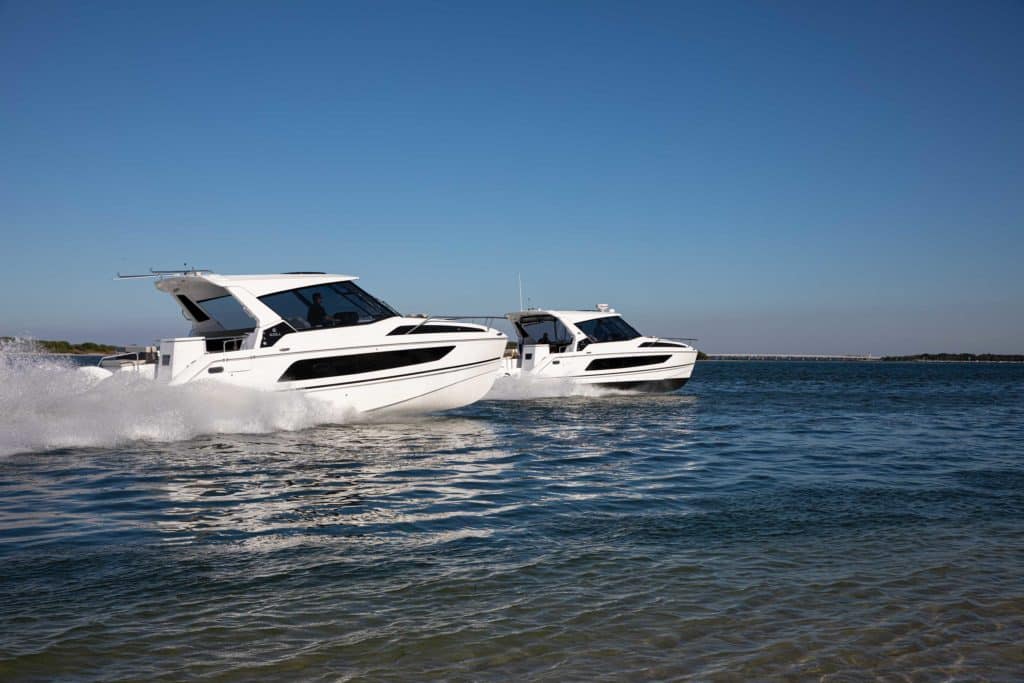
It’s hard to believe a piece of metal with no moving parts can be the approximate equivalent of adding 200 horsepower, 100 gallons of fuel and 100 miles of extra range. But when it’s a hydrofoil attached between the hulls of an Aquila 36 Sport power catamaran (above, far right), that’s the net effect.
While the efficacy of foiling boats is well-documented, this technology has surprisingly had little impact on the recreational powerboat market. Hydrofoils that lift a hull entirely out of the water seem to be too alien to most boaters. Plus, most foil designs require dynamic control using computers to remain aloft at a constant elevation. But they are proven to be effective. With the Aquila 36 Sport, we experienced its benefits on a recreational boat and compared it in real time to the same boat without a foil but with 200 extra ponies. Here’s what we found.
Hydro What?
Gino Morrelli and Pete Melvin, of Morrelli and Melvin Design and Engineering, applied their decades of foiling experience to design the Hydro Glide Foil System for Aquila. It consists of a main hydrofoil attached slightly aft amidships to each hull and the top of the tunnel. It lifts approximately 40 percent of the hull’s weight out of the water when at cruise speeds, for better performance and fuel economy. Farther back, twin fins act like an airplane’s horizontal stabilizers to prevent porpoising at higher speeds. What makes hydrofoils so effective is the dramatic reduction in drag. A typical planing hull has a 4-to-1 lift-to-drag ratio, while a hydrofoil can have up to a 25-to-1 lift advantage.
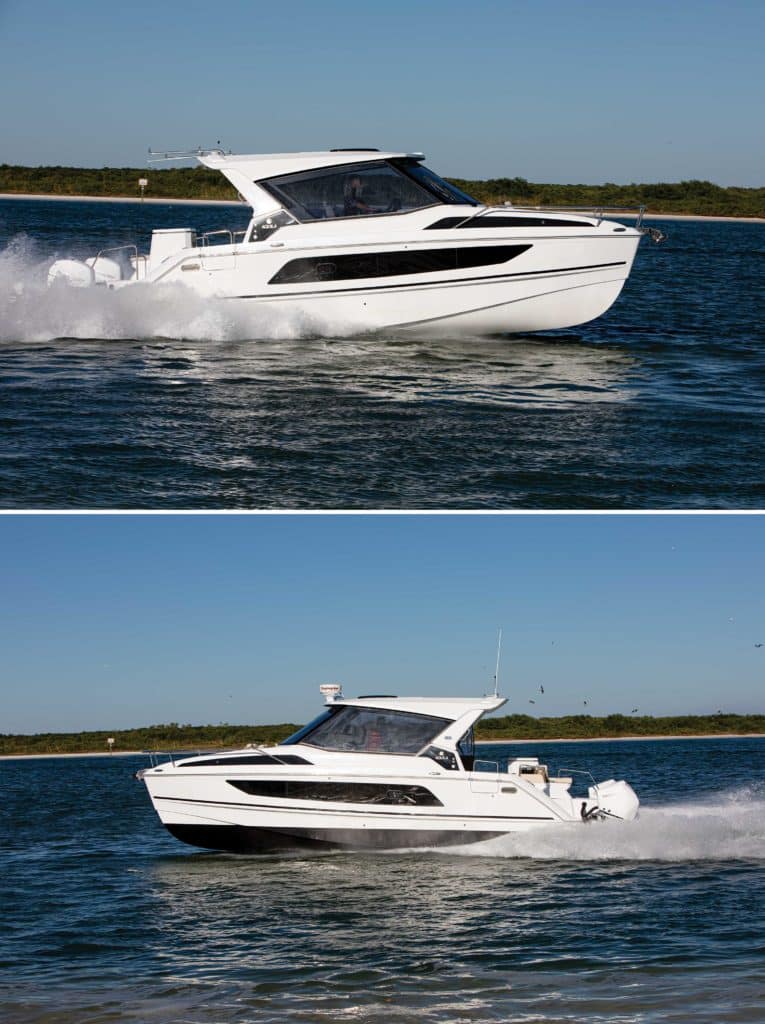
How does it work? The fields of aerodynamics and hydrodynamics are kissing cousins, so many of the principles of one apply to the other. The silhouette of a typical asymmetric hydrofoil wing wouldn’t look out of place on a 737. It consists of a convex curve on the upper side and a flatter bottom side. These taper down toward the rear. Bernoulli’s principle explains that when air or water rushes over the top side of a wing, the medium has to travel farther, so it moves faster. This creates lower pressure on top, allowing the higher pressure on the bottom to push upward.
Sir Isaac Newton’s third law also applies to hydrofoils. The simplified version says that for every action, there is an equal and opposite reaction. So, if a foil is directing the water down, it’s pushed back and the foil rises, creating lift. This effect is enhanced by an increased angle of attack at the leading edge to create more lift. In the case of Aquila’s Hydro Glide foil, it will still provide lift even if the boat’s bow is pointing down 3.5 degrees, which will be useful when running down-sea because it avoids transforming the hydrofoil into the equivalent of a down-planer or sea anchor.
Too much lift can also be a problem, according to Alain Raas, brand manager for Aquila Boats. “Because water is denser, a hydrofoil creates about 830 times more lift for the same area and speed compared to an airplane wing, so you can use a much smaller foil in water than air,” Raas says.
Most hydrofoils operate near the surface and can ventilate, which is a phenomenon that occurs when the low-pressure side of a foil pulls air from the surface and destroys lift on the foil, Raas explains. “Foil depth, sweep, dihedral and section shape all play a significant role in avoiding ventilation,” he adds.
Dueling Aquilas
We were able to arrange a test staging out of MarineMax in St. Pete Beach, Florida. MarineMax is Aquila’s exclusive distributor in the US. The Aquila brand is owned by the Sino Eagle Group, a high-tech Chinese builder that extensively uses vacuum-infusion technology to build the boats. J&J Design Group provided a complete design package for the Aquila 36 Sport.
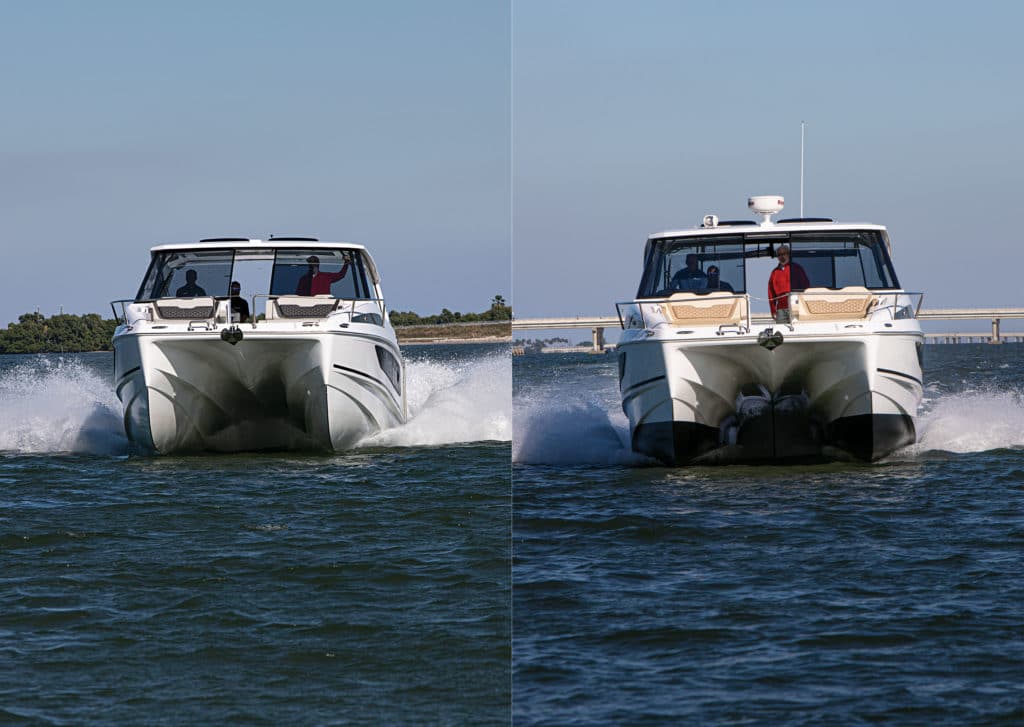
Aquila is largely the brainchild of Lex Raas, Alain’s father and president of Aquila at MarineMax. Lex is South African, and his career journey has taken him from working for Beneteau (the world’s largest boatbuilder) to the Moorings (the world’s largest vacation charter operation) to MarineMax (the world’s largest boat dealer). While a big believer in power catamarans for their roominess and comfort, Lex didn’t like that most were converted sailing vessels. The unveiling of the Aquila 36 Sport power catamaran in 2017, the company’s first outboard-powered model, ushered in a new era of high performance. Because these boats would be used on bareboat charters driven by skippers of varying degrees of expertise, they are purposely designed to be easy to pilot.
One Cool Cat
Our first sea trial began aboard the nonfoiled Aquila, joined by Alain Raas and Jacob Coyle, a MarineMax sales associate. When we headed out into the Gulf of Mexico through the Pass-a-Grille entrance, the wind was blowing 17 mph and gusting to 23 mph from the northwest, creating steep 4-foot waves. In other words, it was a glorious cat day.
Our nonfoiled test boat was powered by a pair of Mercury Verado 400 outboards derived from the Mercury Racing division. This engine does some serious overachieving given its smallish 2.6L inline-six-cylinder block, thanks to twin-scroll superchargers, which lend it substantial punch when a driver needs a blast of power. Ultra-rapid acceleration is less important for catamarans, which usually do best in rough water when kept at a steady speed that is faster than you would think.
Read Next: Aquila 36 Test
The big difference between most power cats and the 36-foot Aquila 36 Sport is the Aquila’s incredible 14-foot-7-inch beam, which creates a living room’s worth of space in the cockpit/salon for up to 26 passengers and is mostly enclosed by an optional hardtop. In addition to helping its optional Joystick Docking for Outboards system work more efficiently, this wide footprint creates an ultra-stable platform that will be reassuring to those without sea legs (or stomachs). It’s so stable, according to Alain, no customers have ever asked Aquila to install a Seakeeper gyrostabilizer.
Settling into a cruise speed of 33 mph felt like the cat’s happiest velocity for that sea state. The narrow profile of the twin hulls cleaved the water without the pounding that characterizes most monohulls when running into steep waves. We used a little bit of engine trim to bring the bow of the hulls out of the water to reduce drag and prevent bow steering, and the boat offered a smooth ride, even when we turned the beam to the waves. Narrower cats of similar lengths can snap-roll alarmingly in large beam seas, but the Aquila remained surprisingly level.
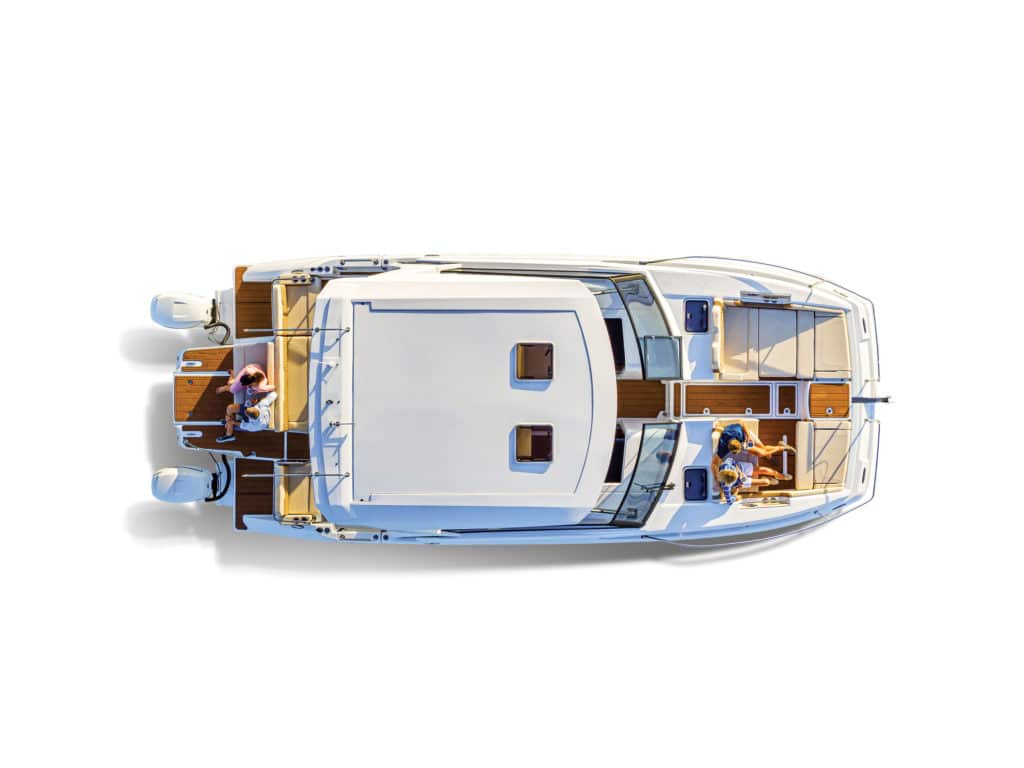
Heading into Bunces Pass is tricky because of shoaling on each side, but once through, it put us squarely into the Tampa Bay area’s recreational boating epicenter. With Egmont Key State Park and Fort De Soto Park to starboard and Shell Key Preserve to port, we were surrounded by great beaches that are perfect to nose up to. The Aquila 36 Sport Hydro Glide showed off its ability to float in just 2 feet of water with the engines trimmed up as we beached it. We beached the foil boat too. Even though the bottom of the foil is about a foot lower than the hulls, its extruded aluminum construction is stout enough to withstand being gently beached.
Time to Fly
Switching boats, we were curious to feel the difference the foil makes. The experience was subtle. The Hydro Glide foil is positioned just forward of the boat’s longitudinal center of gravity and set at zero degrees of attack, allowing the driver to use engine trim to increase the angle for optimal lift. On this boat, little trim is needed because the optimal angle of attack of the hydrofoil is only about 1.5 degrees, according to Lex. In our case, because the fuel tanks were almost full, we just trimmed the engines to their neutral position and let the weight of the fuel give the Aquila 36 Sport Hydro Glide its proper bow-up angle.
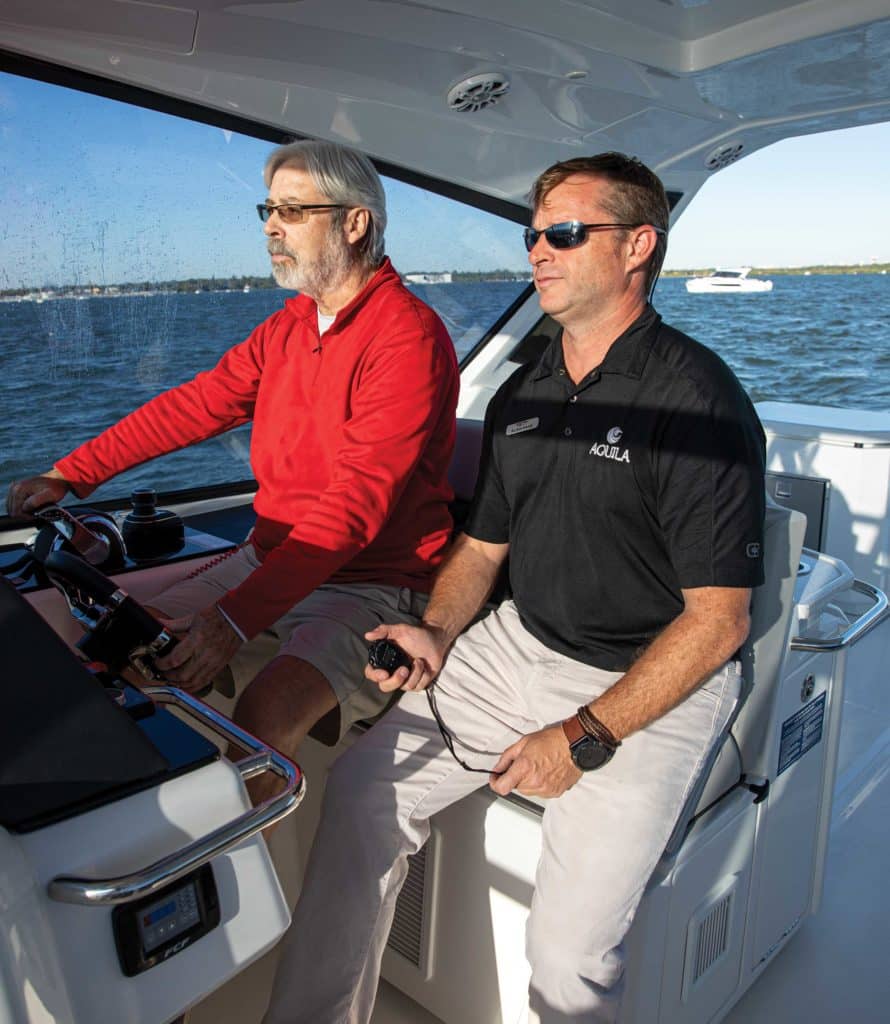
Because the Hydro Glide Foil System lifted the hull only about 6 inches, there was a general feeling of riding higher in the water, but the most tangible evidence was how the steering felt lighter and more responsive—an indication that the foil is running at its proper angle of attack. The wake behind us flattened out significantly, unlike the tall rooster tail and wake that shot aft from the nonfoiled boat. Offshore, it handled the steep chop well and felt best at a cruise speed of 38 mph. There was never a moment when it lost its lift from the foil.
Another difference lay in the cornering characteristics. Without the foil, the 36 Sport has a slight lean to the outside, which some find off-putting. With the Hydro Glide foil, the cat leaned slightly inward and felt nimbler as it carved hard turns. A driver can overcook it during extremely hard turns—the hulls can dig in and turn more sharply than expected—so whipping it into a corner like it’s a jet boat isn’t advised.
Foils that raise a boat’s hull entirely out of the water can plummet should the boat lose lift. But the dihedral V-shape of the Aquila’s foil allows it to descend a little at a time when exposed above the water. This results in gentle corrections in heave, or a boat’s up-and-down motion.
The Numbers Don’t Lie
The Aquila 36 Sport Hydro Glide reached plane in 6.4 seconds, which was 1.4 seconds faster than the nonfoiled boat. Its zero to 30 mph time was 2.4 seconds quicker, taking 12.4 seconds. While those might sound like modest gains, remember this test boat had twin 300 Mercury Verado engines—200 fewer horses than the nonfoiled boat. Of course, these 300s are the new-generation Mercury V-8 engines, featuring 4.6L in a naturally aspirated design instead of the 400′s 2.6L twin-supercharged powerplant. Having two more cylinders and 2 liters of increased displacement negates the need for supercharging because big blocks inherently have more low-end torque.
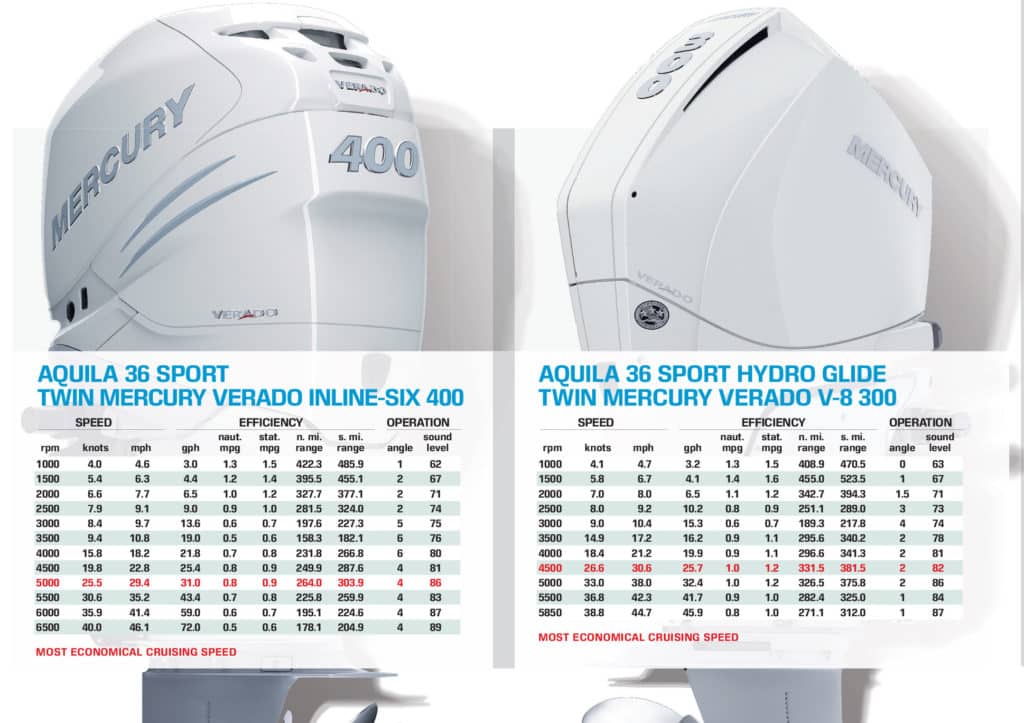
Most impressive was the lack of penalty for going fast on the 36 Sport Hydro Glide. Even at its top speed of 44.7 mph, it was still getting nearly 1 mpg, and the effect on its range was dramatic. At that speed with a full 356-gallon tank, we could theoretically travel the 322 miles from St. Pete Beach to Havana, though exceeding our 10 percent reserve. The nonfoiled Aquila 36 Sport, traveling at its top speed of 46.1 mph, would fall well short of reaching Key West (231 miles away) with a full tank. At its best cruise speed of 30.6 mph, the hydrofoil-equipped Aquila can go 381.5 miles, compared to the nonfoiled version’s 303.9-mile range, when traveling at 29.4 mph, factoring in a 10 percent reserve.
At first blush, opting for the Hydro Glide Foil System might cause sticker shock with its $32,452 price tag, which equates to running through about 13,000 gallons of fuel at $2.50 per gallon to recoup the investment. But if you factor in the difference in buying a pair of 300s versus 400s, the price is much closer, and you get a better-handling boat with more capability because of its increased range. Aquila 36 Sport owners will be happy to discover the Hydro Glide Foil System can be retroactively fitted at an estimated additional labor cost of $10,000. Twin 300s are the max power with the foil because higher speeds cause cavitation, which then adds drag. But the improvements in ride, acceleration and range make this the biggest no-brainer on the options list.
- More: Aquila , Boats , Cruising Boats , versus
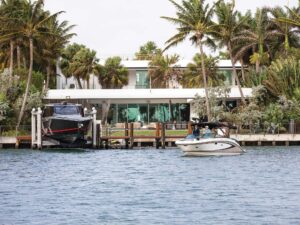
Conveniently Rent a Boat Using Boatsetter
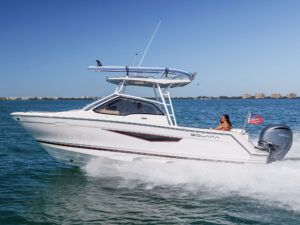
Boat Test: 2024 Solara S-250 DC
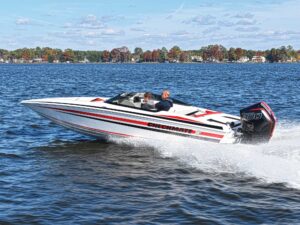
Boat Test: 2024 Checkmate Pulsare 2400 BRX
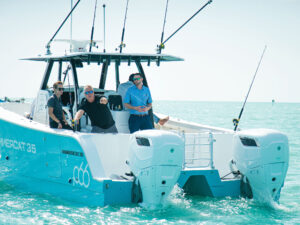
Cox 350 Diesel Outboard
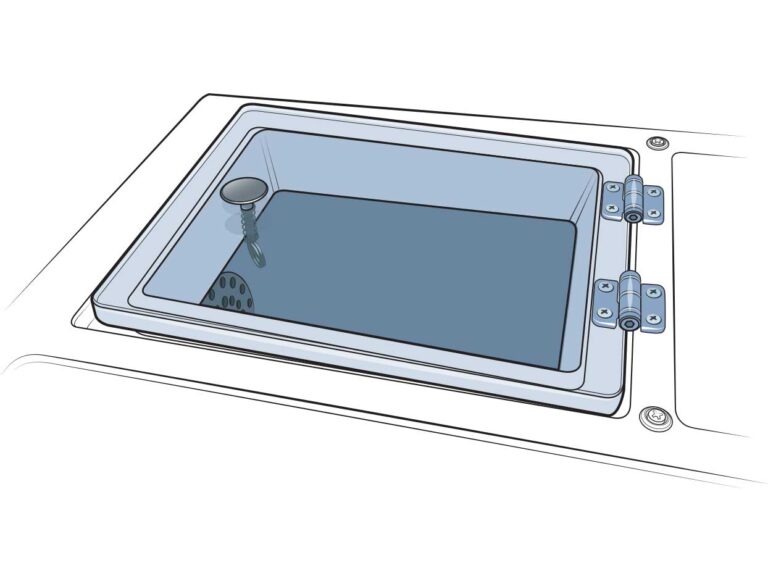
Installing Clear Acrylic Livewell Lids
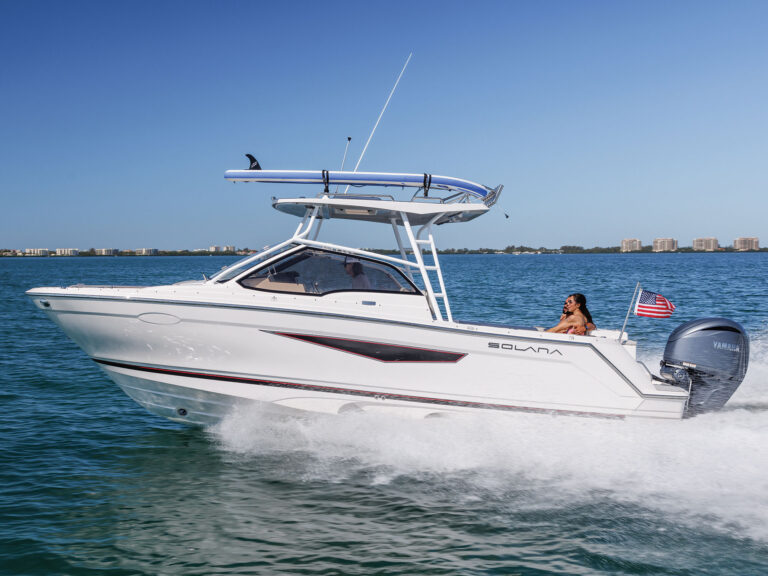
- Digital Edition
- Customer Service
- Privacy Policy
- Cruising World
- Sailing World
- Salt Water Sportsman
- Sport Fishing
- Wakeboarding
Many products featured on this site were editorially chosen. Boating may receive financial compensation for products purchased through this site.
Copyright © 2024 Boating Firecrown . All rights reserved. Reproduction in whole or in part without permission is prohibited.

- Fire Rescue
- Passenger Ferries & Excursion Vessels
- Pilot Boats
- Military Boats
- Law Enforcement
- Utility & Work Boats
- Inland Commercial Vessels
- Windfarm Support Vessels
- Other Commercial Vessels
- Metal Shark Yachts
- Autonomous Vessels
- Recreational Boats
- Passenger Ferries
- Monohull Pilothouses
- Center Consoles
- Towboats & Pushboats
- Metal Shark – Jeanerette
- Metal Shark – Franklin
- Company Contacts
- Construction
- The Metal Shark Advantage
- Training & Support
- Replacement Parts
- Supplier Portal

40 Foil-Assisted Catamaran
Typical specifications.
LOA: 40’ BOA: 14’
For detailed specifications, contact us today.
The “Flying Hub II” shown here is a 40-foot custom welded-aluminum passenger vessel designed by Jutson Marine Design and built by Metal Shark for a Florida-based fishing and tour boat operator. This innovative vessel features a highly efficient foil-assisted catamaran hull and has been built to USCG Subchapter T standards.
Hull Design
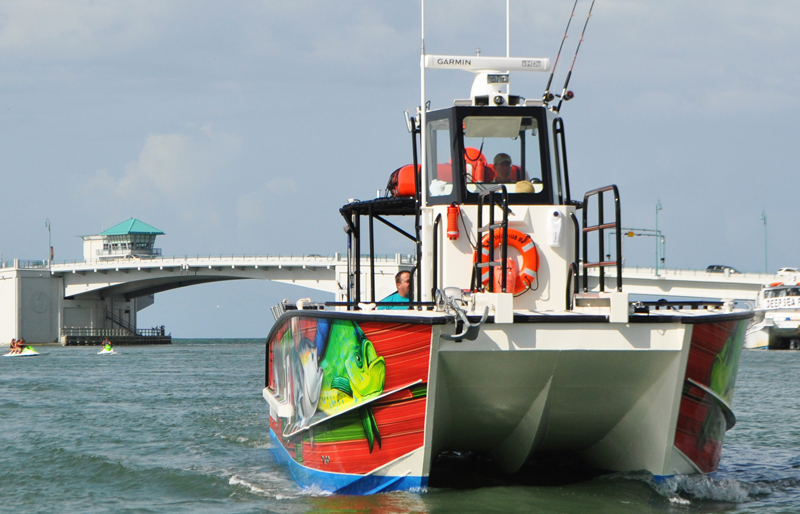
Deck Layout
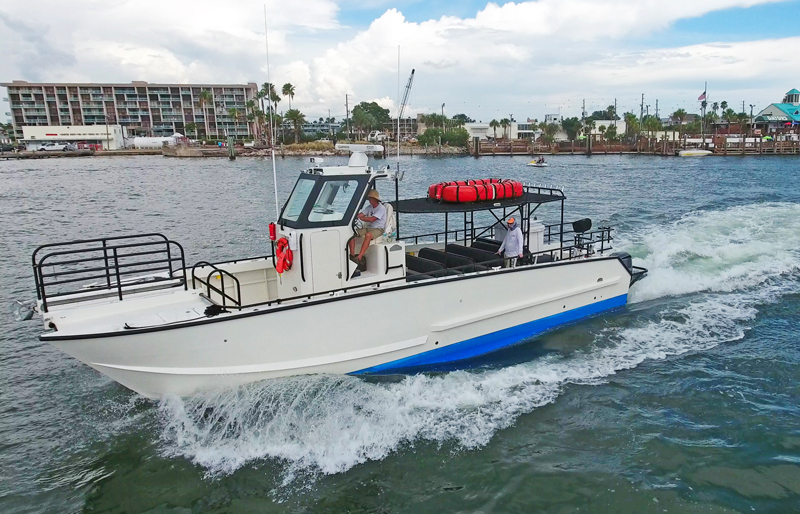
40 Foil-Assisted Catamaran Image Gallery

- Green Propulsion
- Renewable Energy
- Energy efficiency
- Sustainable materials
- News & Events
- Sunreef News Magazine
- Press About Sunreef

- 60 Sunreef Power
- 70 Sunreef Power
- 80 Sunreef Power
- 100 Sunreef Power
- Sunreef Supreme Power
- Sunreef Ultima Range
- Sunreef 44 Ultima
- Sunreef 55 Ultima
- Sunreef 66 Ultima
- Sunreef 77 Ultima
- Sunreef 88 Ultima
- Sunreef fleet

- Sunreef Zero Cat
- Sunreef 100
- Sunreef Fleet

- Sunreef 43M
- 49M Sunreef Power
- 210 Sunreef Power Trimaran
- Sunreef Explorer
- 40M Sunreef Explorer
- 40M Sunreef Explorer Eco
- 50M Sunreef Explorer
- Superyachts Fleet
Sunreef Yachts Presents the World First Hydrofoil System for Luxury Open Catamarans

Catamarans offer several specific features that make them a perfect alternative for traditional yachts, e.g. a bigger living space (sometimes even twice as big as on a single-hull vessel), excellent stability and a very long cruising range. However, enthusiasts of motor vessels choose catamarans primarily for their high performance.
In order to meet needs and expectations of our customers, Sunreef’s naval architects team decided to develop a system of retractable hydrofoils that will enable luxurious Sunreef vessels to attain a maximum speed up to 70 knots and literally fly over the surface of water. Such a solution is the best choice for all those who want to fully exploit the potential offered by power boats.
Hydrofoils in catamarans are used to reduce drag that directly affects the speed of a vessel. A vessel fitted with hydrofoils is lifted out of the water which significantly decreases drag, consequently allowing for greater speeds. Additionally, due to excellent stability of catamarans (ensured by two independent hulls), a vessel is adequately balanced without the need to employ complicated stabilizing systems. As a result, both helmsmen and passengers are offered the ultimate comfort and safety even at considerable speeds (such a combination is not possible in case of standard single-hull vessels).
The first model fitted with hydrofoils will be the Sunreef 40 H – a 40-feet motor catamaran of an open type. A specialist in luxurious, custom-made, multi-hull vessels, the Sunreef Yachts shipyard is going to present a perfectly finished catamaran with sleek, sporty silhouette that will be the ideal choice for everyone who values perfect design and top performance.

Previous Post Sunreef Yachts Announces Its Presence at the Monaco Yacht Show 2014
Next post sunreef yachts presents the new sunreef 74 sailing catamaran.
Comments are closed.
SUBSCRIBE TO OUR NEWSLETTER
- Sailing Yachts
- Power Yachts
- Superyachts
- Making a Change
- Green Concept
- Energy Efficiency
- Sustainable Materials
- ECO Q&A
Copyright © 2024 Sunreef Yachts . All rights reserved.
- Whistleblowing
- Privacy Policy

Sunreef Venture S.A.
Sunreef Yachts Shipyard
ul. Tarcice 6
80-718 Gdańsk, Poland
+48 58 769 77 77
- No results were found.
36 Sport Power Catamaran
The Aquila 36 Sport is a totally innovative approach to having fun on the water. An outboard propelled power catamaran that can day boat with a multitude of revelers and all their water-toys or provide complete privacy for two couples on an adventure to newfound destinations, all with a multitude of options that support everything from invigorating watersports to sportfishing.
Available with a sport windscreen, full windscreen to the hardtop or fully enclosed helm deck with air conditioning (cruiser package option), the Aquila 36 Sport can accommodate most conditions.
The controls are strategically positioned to give the operator complete command of the vessel and the Mercury Joystick Piloting option makes docking and close-in maneuvering intuitively simple. Easily operated and safely able to manage open seas, the Aquila 36 Sport is in a class of its own.
Read on for details on cruiser package option and the fishing/diving version.
Request Information
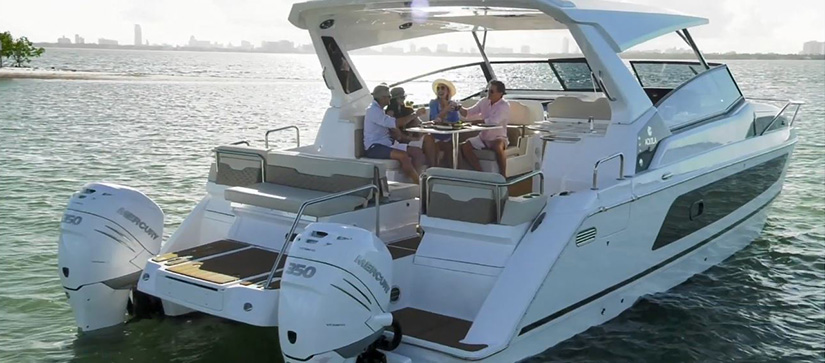
Plenty of Liveaboard Space
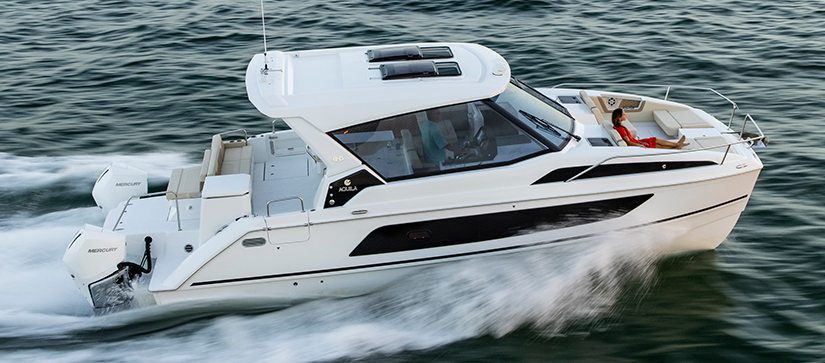
Aquila 36 Sport VIDEO – FEATURING Hydro Glide Foil System™
Want to see the Aquila 36 Sport with Hydro Glide Foil System ™ in action? Check out the full performance evaluation and walkthrough by BoatTEST as they put this model and innovation to the test.
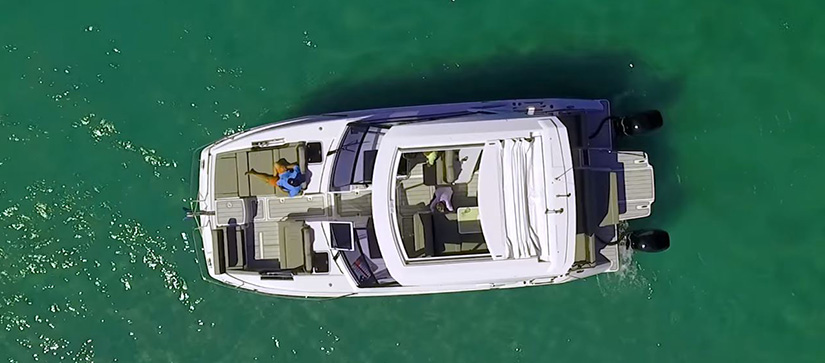
Hear it from the Owners
Take a virtual walkthrough.
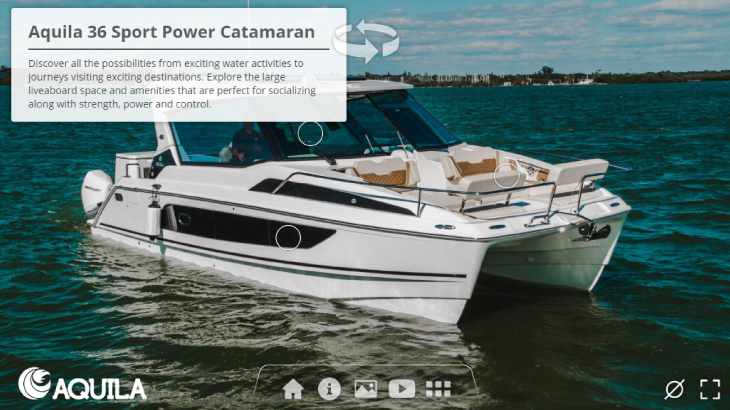
Discover the Possibilities
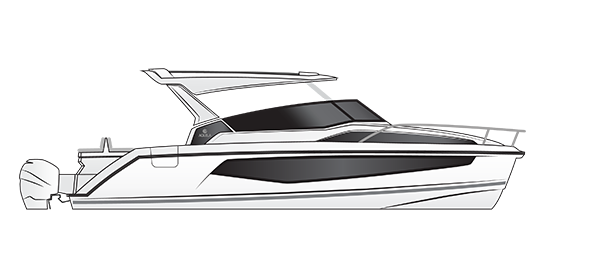
Specifications
- Download Specs
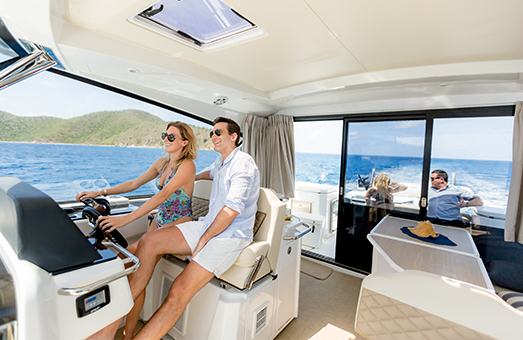
Now Available as a Cruiser
Enjoy maximum comfort and control with the new cruiser package option. Featuring an aft 3-panel tempered glass sliding door which can be locked into place, the cruiser package option allows you the ability to close off the entire salon and galley for increased privacy, security, and relaxation. In addition to the improved climate control and aesthetics, the Aquila 36 Sport cruiser option offers accent wood in the salon, and Infinity carpet throughout the salon and galley. The already stellar Aquila 36 Sport now provides more luxury than ever before.
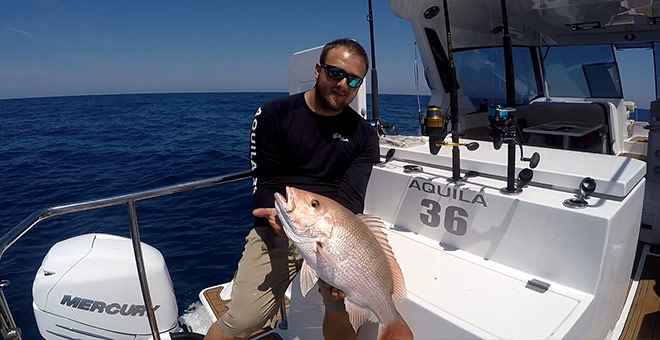
Fishing and Diving Version
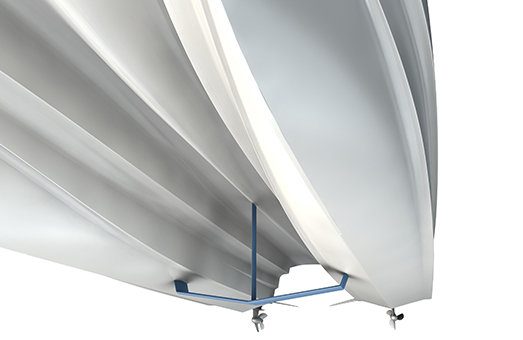
Hydro Glide Foil System
- Discover the Technology
BoatTEST – Featuring Hydro Glide Foil System™
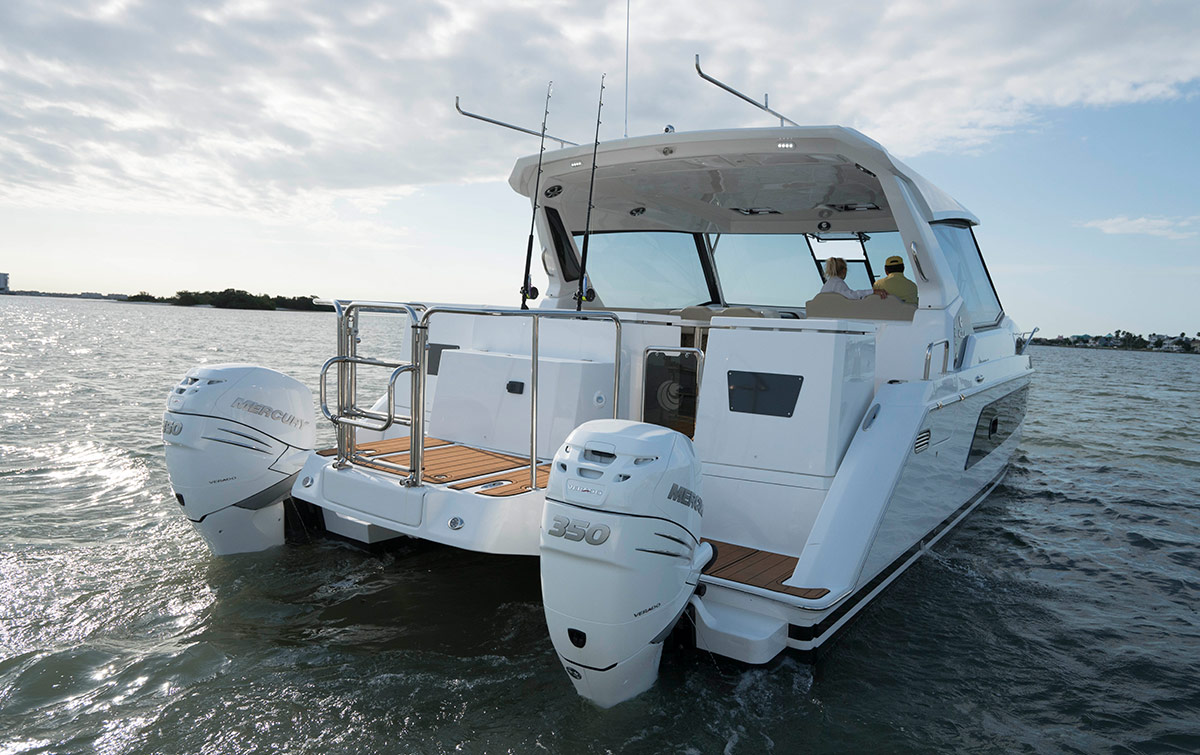
Aquila Models
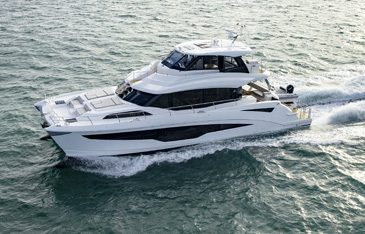
Aquila 70 Luxury
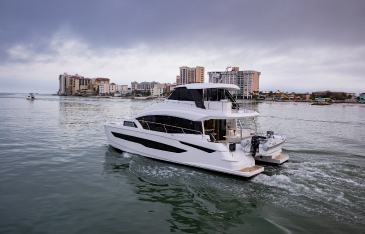
Aquila 54 Yacht
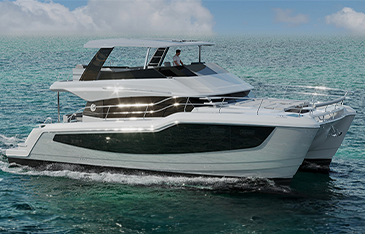
Aquila 50 Yacht
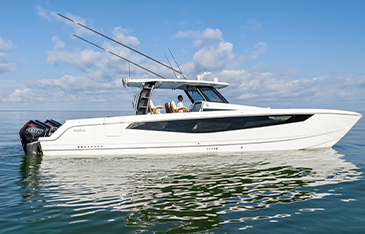
Aquila 47 Molokai
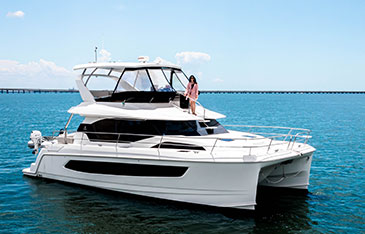
Aquila 44 Yacht
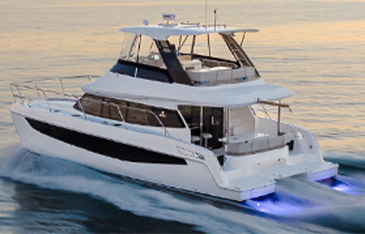
Aquila 42 Yacht
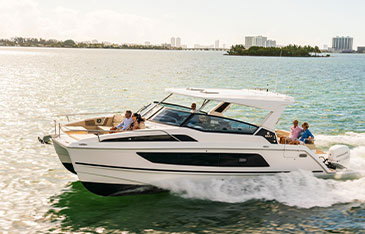
Aquila 36 Sport
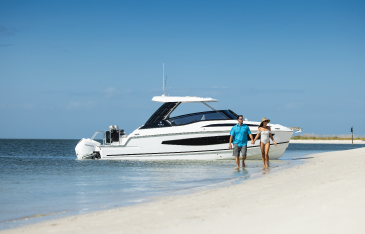
Aquila 32 Sport
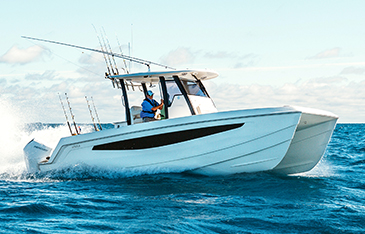
Aquila 28 Molokai
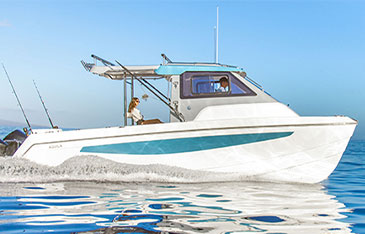
Aquila 28 Molokai Cuddy
- Skip to primary navigation
- Skip to main content
- Skip to footer
Inspired in Kodiak Tailored Professional Design Built in Alaska
Alaskan aluminum power catamarans, llc.
Specializing in building aluminum, hydrofoil assist, outboard powered catamarans
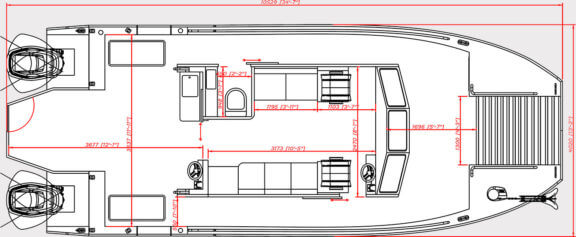
Alaskan Aluminum Power Catamarans specializes in the design and building of aluminum, hydrofoil assist, outboard powered catamarans; producing a welded aluminum boat specifically designed for operating in our rugged Alaskan environment. Each of our boats is influenced by a lifetime Alaskan resident who has spent most of his life both commercially fishing and sport fish guiding around Kodiak. They are designed by an accomplished naval architect specializing in hydrofoil assist catamarans, and each boat is built here in Alaska by a team well versed in fabricating within Alaska’s Commercial Fishing and Sport Boating industry.
The catamaran-style hull is well known for its stability, extra width, and fuel efficiency. However, the asymmetrical hulls on our boats recognize that the water inside a catamaran’s tunnel is different from the water displaced on the outboard sides of the boat when underway. This design helps to further improve on the catamaran idea; preparing for and mitigating chop entering the tunnel for a smoother ride at speed, as well as minimizing drag, increasing fuel efficiency, and range.
Our hydrofoil further improves that catamaran concept and acts like an airplane wing securely fixed between the hulls, providing several inches of lift to the entire boat on plane. Lifting the boat reduces the wetted surface, thereby reducing drag, increasing fuel efficiency, speed, and range. Lifting the boat also increases the distance between the water’s surface and tunnel, further softening and improving the ride in chop. Our hydrofoils are designed and placed to maximize lift at practical cruising speeds and anticipate a variety of load conditions.
Cabin and deck layout are easily customizable and easily tailored to suit your specific tastes and goals for your vessel. We are very happy to work with you and include our own personal experiences and suggestions as we help to create your ideal platform; whether you are a charter captain looking for a layout specific to your clients needs, a remote cabin owner interested in hauling material and supplies, or any normal Alaskan looking to take family and friends out for a day or week of fun. These decisions aren’t new to us and we enjoy helping tailor this technology to your application.
PO Box 888 Kodiak, AK 99615 Phone: (907) 891-8534 MyBoat@AlaskanCatamarans.com Facebook Instagram
- Local Politics
- Catch a flight from Tacoma to San Juan Island? Hop aboard
FLYING ABOVE THE SALISH SEA — The blue water sparkled below. The Olympic Mountains gleamed from one side of the seaplane and the Cascades to the other, as Mount Rainier loomed majestic.
“Look how beautiful this is,” said Bill Sterud, chairman of the Puyallup Tribe of Indians, aboard Kenmore Air on an inaugural flight from Tacoma to San Juan Island.
Beginning Thursday, bookings are available for the first time for direct service to San Juan Island from the Puyallup Tribal Air Terminal, the tribe’s seaplane dock at Ruston Way.
This marks the beginning of the second season for the partnership’s flights out of the terminal, and represents the tribe’s growing influence and economic diversity in the region.
Kenmore will fly twice a day to San Juan, starting at $199 per person one way, a special price through June 17 . In its first year, the terminal saw 1,000 people pass through on 100 narrated scenic flight tours of the South Sound .
The flights to San Juan are sure to pump up the action this summer, putting Friday Harbor and Roche Harbor within an easy flight from Tacoma.
The tribe also plans to open a restaurant at the terminal in July, adding to nearby amenities, from the Ruston Way waterfront to the Washington State History Museum, Tacoma Art Museum and Museum of Glass, to private luxury transport to the tribe’s Emerald Queen Casino and special packages for hotel stays and casino play.
And the new route will offer South Sounders an alternative to the Washington State Ferries system, plagued with reliability problems due to shortages of both crews and boats. There were 1,601 missed trips because of cancellations by the ferry system in just the second quarter of fiscal year 2024, according to state data .
No surprise, then, that the delegation from the tribe was welcomed Tuesday at the dock at Friday Harbor by Amy Nesler of the San Juan Islands Visitors Bureau, who presented Sterud with a gift and warm welcome. The flights are expected to be a help to island businesses that have seen a dip of up to 30% in business because of ferry fear — even in August, usually the busiest month, Nesler said.
On the inaugural flight Tuesday, the plane landed smoothly as a seabird at Friday Harbor Marina, just 48 minutes from takeoff. And what a view along the way.
“There is not a prettier flight we do,” said David Gudgel, president of Kenmore Air. He couldn’t resist timing the flight on his phone’s stopwatch — and loved seeing it clock in even faster than expected. The flights will operate from May 16 to Sept. 16.
Next up for the tribe and Kenmore are flights to Victoria, B.C.,’s Inner Harbour from Friday Harbor, now in the planning stages. That puts the heart of Victoria and its many walkable pleasures within a quick zip of a 30-minute flight from the islands.
Before that can happen, the Puyallup Tribe and Kenmore Air have been working with the Washington congressional delegation to work through some roadblocks involving an inspection fee proposed by the U.S. Animal and Plant Health Inspection Service. The tribe and other operators of small planes are seeking to reinstate a small-plane exception, or create a new one for flights of fewer than 16 seats.
The fee comes as a particular sting to the tribe: The U.S. government’s initial treaty with the tribe forbade trade on Vancouver Island, a restriction the tribe had to seek legislation to eventually undo. The tribe will keep working to make the flight to Victoria happen, said Matt Wadhwani, a Puyallup tribal member, CEO of Puyallup Tribal Enterprises and the tribe’s financial officer.
One of the planes servicing the new route will be unmistakable: Kenmore Air stripped it down to the metal, repainted it bright white, then wrapped it with the tribe’s trademark red and black salmon logo. Puyallup Tribe of Indians is emblazoned near the plane’s nose.
Kenmore and the tribe did not share financial details of their partnership.
For the tribe, the seaplane terminal and partnership is just one more way of diversifying its economy, Wadhwani said. “It’s a big win.” Today the tribe has a business portfolio that includes its casino, a marina, golf course, convenience stores, cannabis stores, a candy and snack company, and investment in an energy storage company that aims to revolutionize the power grid.
Sterud was all smiles walking down the dock at Friday Harbor for the seaplane flight back to Tacoma that would wing him over the tribe’s traditional territory and fishing sites, and its main ancestral village site at Point Defiance.
“Who would ever believe it,” Sterud said.
Most Read Local Stories
- WA trooper shoots, kills man on I-5 in Everett
- Funder of proposed play area at Seattle nude beach revealed, city plan draws ire
- Seattle drops out of Top 10 for growth among largest U.S. cities
- King County reports largest number of homeless people ever
The opinions expressed in reader comments are those of the author only and do not reflect the opinions of The Seattle Times.
Follow Puck Worlds online:
- Follow Puck Worlds on Twitter
Site search
Filed under:
- Kontinental Hockey League
Gagarin Cup Preview: Atlant vs. Salavat Yulaev
Share this story.
- Share this on Facebook
- Share this on Twitter
- Share this on Reddit
- Share All sharing options
Share All sharing options for: Gagarin Cup Preview: Atlant vs. Salavat Yulaev
Gagarin cup (khl) finals: atlant moscow oblast vs. salavat yulaev ufa.
Much like the Elitserien Finals, we have a bit of an offense vs. defense match-up in this league Final. While Ufa let their star top line of Alexander Radulov, Patrick Thoresen and Igor Grigorenko loose on the KHL's Western Conference, Mytischi played a more conservative style, relying on veterans such as former NHLers Jan Bulis, Oleg Petrov, and Jaroslav Obsut. Just reaching the Finals is a testament to Atlant's disciplined style of play, as they had to knock off much more high profile teams from Yaroslavl and St. Petersburg to do so. But while they did finish 8th in the league in points, they haven't seen the likes of Ufa, who finished 2nd.
This series will be a challenge for the underdog, because unlike some of the other KHL teams, Ufa's top players are generally younger and in their prime. Only Proshkin amongst regular blueliners is over 30, with the work being shared by Kirill Koltsov (28), Andrei Kuteikin (26), Miroslav Blatak (28), Maxim Kondratiev (28) and Dmitri Kalinin (30). Oleg Tverdovsky hasn't played a lot in the playoffs to date. Up front, while led by a fairly young top line (24-27), Ufa does have a lot of veterans in support roles: Vyacheslav Kozlov , Viktor Kozlov , Vladimir Antipov, Sergei Zinovyev and Petr Schastlivy are all over 30. In fact, the names of all their forwards are familiar to international and NHL fans: Robert Nilsson , Alexander Svitov, Oleg Saprykin and Jakub Klepis round out the group, all former NHL players.
For Atlant, their veteran roster, with only one of their top six D under the age of 30 (and no top forwards under 30, either), this might be their one shot at a championship. The team has never won either a Russian Superleague title or the Gagarin Cup, and for players like former NHLer Oleg Petrov, this is probably the last shot at the KHL's top prize. The team got three extra days rest by winning their Conference Final in six games, and they probably needed to use it. Atlant does have younger regulars on their roster, but they generally only play a few shifts per game, if that.
The low event style of game for Atlant probably suits them well, but I don't know how they can manage to keep up against Ufa's speed, skill, and depth. There is no advantage to be seen in goal, with Erik Ersberg and Konstantin Barulin posting almost identical numbers, and even in terms of recent playoff experience Ufa has them beat. Luckily for Atlant, Ufa isn't that far away from the Moscow region, so travel shouldn't play a major role.
I'm predicting that Ufa, winners of the last Superleague title back in 2008, will become the second team to win the Gagarin Cup, and will prevail in five games. They have a seriously well built team that would honestly compete in the NHL. They represent the potential of the league, while Atlant represents closer to the reality, as a team full of players who played themselves out of the NHL.
- Atlant @ Ufa, Friday Apr 8 (3:00 PM CET/10:00 PM EST)
- Atlant @ Ufa, Sunday Apr 10 (1:00 PM CET/8:00 AM EST)
- Ufa @ Atlant, Tuesday Apr 12 (5:30 PM CET/12:30 PM EST)
- Ufa @ Atlant, Thursday Apr 14 (5:30 PM CET/12:30 PM EST)
Games 5-7 are as yet unscheduled, but every second day is the KHL standard, so expect Game 5 to be on Saturday, like an early start.
Loading comments...
- Investigates
- Houston Life
- Newsletters
WEATHER ALERT
9 warnings and an advisory in effect for 22 regions in the area
Fuel barge crashes into galveston bridge, spilling oil and causing ‘major disruption’ in road, water traffic, the only way off pelican island right now is by boat. galveston county judge says fuel is still leaking and shipping is shut down for 6.5 miles getting in and out of the port of galveston.
Ahmed Humble , Digital Content Producer
Robert Arnold , Investigative Reporter
Rilwan Balogun , Reporter
Karen Araiza , Digital Content Lead , Houston
GALVESTON, Texas – A barge hit the Pelican Island Bridge Causeway in Galveston this morning, damaging the bridge, causing an oil spill and shutting off the only access on and off the island by car. It also shut down maritime traffic along the Intracoastal Waterway in and out of the Port of Galveston for more than 6 miles.
- LATEST UPDATE: Evacuations halted on Pelican Island Causeway following barge strike
Structural engineers from the Texas Department of Transportation in Houston are assessing damage to help determine if the bridge is safe enough to open up any part to traffic.
- LISTEN: Dispatch audio reveals response after barge strikes Pelican Island Causeway
Just before 10 Wednesday morning, the fuel barge lost control in the outgoing high tide and hit the bridge, according to David Flores, supervisor with Galveston Navigation District 1.
Steel iron beams and tons of cement was being fixed, according to Flores.
BALTIMORE BRIDGE LATEST: Investigation continues into 4 electrical blackouts on ship that caused Baltimore bridge collapse
No one was hurt.
About 200 people are stuck on Pelican Island, Galveston County Judge Mark Henry told KPRC 2′s Rilwan Balogun.
“If we can get everyone off, I do not anticipate an opportunity to return anytime soon,” Henry said. “We don’t anticipate anyone being stranded on Pelican Island for even overnight, much less an extended period of time.”
Between 20 and 25 vehicles are waiting at Pelican Bay to get off the island, and authorities are hoping to open the bridge up to let those folks out this evening.
Galveston officials also tell KPRC 2′s Assignments Editor Terrence Kelly the U.S. Coast Guard has been called to help with the oil spill. The barge holds 30,000 barrels, according to Judge Henry, but he said they don’t know how much fuel was on it, but it was still leaking Wednesday afternoon.
The barge is owned by Martin Petroleum and when it hit the bridge, it knocked out power temporarily. That has since been restored.
No cars are being allowed across the bridge and no boats or barges in the channel.
The Intracoastal Waterway from Mile Marker 350.5 to Mile Marker 357, approximately 6.5 miles, is shut off and a dozen different agencies are onsite.
“It is a significant impact and I can understand their [people’s] concerns. This will be a major disruption to commercial maritime traffic and pleasure,” Judge Henry said.
PREVIOUS COVERAGE: ‘Couldn’t happen here:’ In light of Baltimore bridge collapse, ship leader says same event wouldn’t happen in Houston
Additionally, Texas A&M has canceled classes for the day, which roughly affected only 30 students because it’s the end of the semester. They’re opening their cafeteria for any students stuck there.
6:30 pm Update: TxDot continues to assess the damage to Pelican Island Bridge. Traffic is no longer exiting Pelican... Posted by Texas A&M University Galveston Campus on Wednesday, May 15, 2024
Judge Henry characterized this crash as significantly different from the Baltimore crash where a cargo ship took down the Key Bridge.
- Cargo ship that caused Baltimore bridge collapse had power blackouts hours before leaving port
“The bridge did not structurally fail. While portions of the bridge did structurally fail, the entire bridge did not,” Henry said. “We did see pieces of the bridge laying on the bow of the barge, but the size and scope is dramatically different. It’s much, much smaller.”
The Pelican Island Causeway Bridge is a critical part of the one road leading to and from Pelican Island.
Over 2,000 people including faculty, staff and students at Texas A&M in Galveston depend on the bridge, according to the student newspaper.
It’s the last drawbridge of its kind in Texas, called a bascule bridge.
A worker operates the lift so boats and barges can pass through to get in and out of the Port of Galveston.
Stay informed with KPRC 2's Breaking News Alerts
Copyright 2024 by KPRC Click2Houston - All rights reserved.
About the Authors
Ahmed humble.
Historian, educator, writer, expert on "The Simpsons," amateur photographer, essayist, film & tv reviewer and race/religious identity scholar. Joined KPRC 2 in Spring 2024 but has been featured in various online newspapers and in the Journal of South Texas' Fall 2019 issue.
Robert Arnold
Award winning investigative journalist who joined KPRC 2 in July 2000. Husband and father of the Master of Disaster and Chaos Gremlin. “I don’t drink coffee to wake up, I wake up to drink coffee.”
Recommended Videos
- Yekaterinburg
- Novosibirsk
- Vladivostok

- Tours to Russia
- Practicalities
- Russia in Lists
Rusmania • Deep into Russia
Out of the Centre
Savvino-storozhevsky monastery and museum.

Zvenigorod's most famous sight is the Savvino-Storozhevsky Monastery, which was founded in 1398 by the monk Savva from the Troitse-Sergieva Lavra, at the invitation and with the support of Prince Yury Dmitrievich of Zvenigorod. Savva was later canonised as St Sabbas (Savva) of Storozhev. The monastery late flourished under the reign of Tsar Alexis, who chose the monastery as his family church and often went on pilgrimage there and made lots of donations to it. Most of the monastery’s buildings date from this time. The monastery is heavily fortified with thick walls and six towers, the most impressive of which is the Krasny Tower which also serves as the eastern entrance. The monastery was closed in 1918 and only reopened in 1995. In 1998 Patriarch Alexius II took part in a service to return the relics of St Sabbas to the monastery. Today the monastery has the status of a stauropegic monastery, which is second in status to a lavra. In addition to being a working monastery, it also holds the Zvenigorod Historical, Architectural and Art Museum.
Belfry and Neighbouring Churches

Located near the main entrance is the monastery's belfry which is perhaps the calling card of the monastery due to its uniqueness. It was built in the 1650s and the St Sergius of Radonezh’s Church was opened on the middle tier in the mid-17th century, although it was originally dedicated to the Trinity. The belfry's 35-tonne Great Bladgovestny Bell fell in 1941 and was only restored and returned in 2003. Attached to the belfry is a large refectory and the Transfiguration Church, both of which were built on the orders of Tsar Alexis in the 1650s.

To the left of the belfry is another, smaller, refectory which is attached to the Trinity Gate-Church, which was also constructed in the 1650s on the orders of Tsar Alexis who made it his own family church. The church is elaborately decorated with colourful trims and underneath the archway is a beautiful 19th century fresco.
Nativity of Virgin Mary Cathedral

The Nativity of Virgin Mary Cathedral is the oldest building in the monastery and among the oldest buildings in the Moscow Region. It was built between 1404 and 1405 during the lifetime of St Sabbas and using the funds of Prince Yury of Zvenigorod. The white-stone cathedral is a standard four-pillar design with a single golden dome. After the death of St Sabbas he was interred in the cathedral and a new altar dedicated to him was added.

Under the reign of Tsar Alexis the cathedral was decorated with frescoes by Stepan Ryazanets, some of which remain today. Tsar Alexis also presented the cathedral with a five-tier iconostasis, the top row of icons have been preserved.
Tsaritsa's Chambers

The Nativity of Virgin Mary Cathedral is located between the Tsaritsa's Chambers of the left and the Palace of Tsar Alexis on the right. The Tsaritsa's Chambers were built in the mid-17th century for the wife of Tsar Alexey - Tsaritsa Maria Ilinichna Miloskavskaya. The design of the building is influenced by the ancient Russian architectural style. Is prettier than the Tsar's chambers opposite, being red in colour with elaborately decorated window frames and entrance.

At present the Tsaritsa's Chambers houses the Zvenigorod Historical, Architectural and Art Museum. Among its displays is an accurate recreation of the interior of a noble lady's chambers including furniture, decorations and a decorated tiled oven, and an exhibition on the history of Zvenigorod and the monastery.
Palace of Tsar Alexis

The Palace of Tsar Alexis was built in the 1650s and is now one of the best surviving examples of non-religious architecture of that era. It was built especially for Tsar Alexis who often visited the monastery on religious pilgrimages. Its most striking feature is its pretty row of nine chimney spouts which resemble towers.

Plan your next trip to Russia
Ready-to-book tours.
Your holiday in Russia starts here. Choose and book your tour to Russia.
REQUEST A CUSTOMISED TRIP
Looking for something unique? Create the trip of your dreams with the help of our experts.
Ship that toppled Baltimore bridge had lost power twice before leaving port, NTSB reports

The massive container ship that toppled the Francis Scott Key Bridge had lost power twice in the hours before it left the Port of Baltimore, according to a preliminary report released Tuesday by the National Transportation Safety Board.
The NTSB has been investigating the collision, which killed six people and destroyed critical infrastructure, since it occurred in the early morning hours of March 26. Its report offers the first official accounting of the events leading up to the disaster, as well as its immediate aftermath.
About 10 hours before leaving port, the container ship Dali experienced a blackout during maintenance when a crew member accidentally closed an inline engine exhaust damper. This blocked the engine’s exhaust from exiting the vessel and stalled the engine, the NTSB report states .
Crew members restored power by manually closing two breakers, but then a second blackout occurred due to insufficient fuel pressure in one of the ship's generators. The crew successfully restarted that generator by reopening its exhaust damper.
“While recovering from this second blackout,” the report notes, the crew switched the ship’s electrical configuration to use a different set of breakers than what it had been using for the past several months. It was these new breakers that were in use when the ship departed hours later.
What happened after the Dali left the Port of Baltimore?
The Dali left port at 12:36 a.m., assisted by two tug boats and a pair of pilots from the Association of Maryland Pilots. Nine minutes later, the senior pilot ordered the tugboats to be let go, and the Dali was navigating the channel under its own power, the report shows.
USAT investigation: How many ships hit bridges, lose power every year? Data shows jarring numbers on the rise.
Less than an hour later, at 1:25 a.m. the two electrical breakers that supplied most of the ship’s power tripped, causing the first blackout offshore and resulting in the shutdown of the main engine and steering mechanism. At that moment, the Dali was 0.6 miles away – or three ship lengths – from the bridge, the report notes.
The voyage data recorder was also affected by the blackout and stopped recording the ship’s system data for about one minute, although it had continued to record audio.
“The Dali crew was able to restore electrical power to the vessel, but, when the ship was 0.2 miles from the bridge, a second electrical blackout occurred,” the report said, noting that the breakers that connected to two of the ship’s generators had tripped, “causing a total loss of vessel electrical power.”
By that time, one of the pilots on board had already alerted a dispatcher on shore, and the dispatcher was able to notify the Maryland Transportation Authority Police, which closed the bridge to traffic.
But seven road maintenance workers and one inspector were still on the bridge when the ship struck. The inspector was able to run to the nearest surviving span before the bridge collapsed and survived.
Thirty-one seconds later, the crew manually closed the breakers and restored electrical power but was unable to regain propulsion. Less than one minute afterward, the Dali struck the bridge.
All the maintenance workers, who were in their vehicles at the time, fell into the Patapsco River along with the bridge. One of the workers was able to free himself from his truck and survived with injuries. The rest died.
A crew member on the Dali also sustained minor injuries fleeing debris when part of the span fell on top of the ship, the report said.
Could tugboats have saved the Dali and the Key Bridge?
Absent from the report is any comment about whether the first set of power outages, or the crew’s efforts to fix them, were related to the second set of power outages once the ship was sailing.
“We have to wait for a more detailed inquiry to see if it was related at all to it,” said Ashok Pandey, a master mariner and associate professor of maritime business at the Massachusetts Maritime Academy, who reviewed the NTSB report at the request of USA TODAY.
Pandey said it’s standard operating procedure to perform a thorough test of the ship’s controls and its main engine shortly before departure. Though the test isn't mentioned in the NTSB report, Pandey said the test’s findings would have been logged and any major problems communicated to both the ship’s owner and management company.
The ship’s top commanders probably “didn’t feel there was anything that would prevent the ship from sailing,” Pandey said. “So I’m not reading too much into it, unless an inquiry finds there was something amiss that was missed by all that could have contributed to the engine blackout.”
Regardless of what caused the blackout, Pandey said, he believes the disaster could have been averted, or at least minimized, had the Dali used tug escorts all the way through the channel and out to sea.
“That’s the glaring human error here,” he said, referring to the lack of mandatory tug escorts . “It’s a larger problem that the industry has to deal with here.”
The ship's owners and Baltimore officials are in court over responsibility
The NTSB account confirms what The Associated Press had reported in April – that the Dali had suffered apparent electrical issues before it left port, which was based on information from an anonymous source. The city of Baltimore repeated that information in a lawsuit it filed last month against the ship’s owner and manager for damages related to the incident.
The city also argued that neither the ship’s owner, Grace Ocean Private Ltd., nor its manager, Synergy Marine Private Ltd., should be allowed to limit their liability in the case, claiming both had failed to properly train and supervise the crew, failed to follow safe work and operational procedures, and failed to properly maintain, equip and inspect the vessel.
The filings were submitted in response to a petition by the Dali’s owner and its management company seeking to limit their financial liability for the collision; they claimed they were not at fault.
Grace Ocean and Synergy have been participating in the investigation, along with other agencies, associations and companies. The FBI separately has been investigating the incident, the agency confirmed last month.
What did the NTSB find in drug and fuel tests?
A spokesman for Synergy Marine, Darrell Wilson, confirmed the company’s involvement in the investigation but declined further comment “out of respect for the investigations and any future legal proceedings.”
“We again extend our deepest sympathy to all of those impacted by this incident,” Wilson said in an email to USA TODAY.
In addition to detailing the power outages leading up to the bridge collision, the NTSB report ruled out two other potential factors in the disaster – substance use and fuel problems.
The ship’s entire crew underwent drug and alcohol testing less than an hour after the crash and again a few hours later, per U.S. Coast Guard regulations. All tested negative.
Both pilots also were administered drug and alcohol tests once they got back ashore. Those, too, were negative, the report said.
At the time of the incident, the Dali was burning low-sulfur marine gas oil procured from Newark, New Jersey. Testing of that fuel determined that it complied with international standards and regulations and raised no concerns about its quality.
Several marine experts had speculated that dirty fuel – a common problem in commercial vessels and one that can gum up an engine – could have played a role in the ship's power outage. The report's findings say otherwise.
What's next in the NTSB's Key Bridge investigation?
The NTSB said that its work continues. For example, the report noted, its investigators are still examining the Dali’s propulsion and electrical system, analyzing and validating its voyage data recorder and have planned interviews with numerous stakeholders.
The agency also is assessing other bridges to see if they need improved pier protection. It specifically named the Gov. William Preston Lane Jr. Memorial Bridge – also called the Bay Bridge – near Annapolis, Maryland, as one such bridge.
“Planned areas of investigation,” the report said, “include oceangoing vessels’ propulsion and electrical systems; the frequency and causes of vessel contacts with bridges over navigable waters; and bridge-strike mitigation measures such as a combination of vessel-size restrictions, vessel-assist tugs, and bridge-pier protection.”
Advertisement
Supported by
Ship That Hit Baltimore Bridge Had 2 Electrical Failures Before Departure
A report from the National Transportation Safety Board said crew members had adjusted the electrical configuration of the ship even before it left port.
- Share full article

By Mike Baker and Nicholas Bogel-Burroughs
In the hours before a wayward cargo ship lost electrical power and knocked down Baltimore’s Francis Scott Key Bridge, killing six people, the vessel suffered two blackouts while still in port, according to a preliminary report released on Tuesday.
In a 24-page summary of findings so far, investigators with the National Transportation Safety Board said the Dali cargo vessel had experienced at least two electrical failures on the day before the accident, causing the crew to adjust the configuration of the electrical system about 10 hours before setting out.
The investigators said they were still examining what effect the earlier repairs may have had. But they said it was apparent that the trouble that led to the accident began when the vessel’s electrical circuit breakers tripped, leading to a loss of propulsion and steering capacity.

The Unique Burial of a Child of Early Scythian Time at the Cemetery of Saryg-Bulun (Tuva)
<< Previous page
Pages: 379-406
In 1988, the Tuvan Archaeological Expedition (led by M. E. Kilunovskaya and V. A. Semenov) discovered a unique burial of the early Iron Age at Saryg-Bulun in Central Tuva. There are two burial mounds of the Aldy-Bel culture dated by 7th century BC. Within the barrows, which adjoined one another, forming a figure-of-eight, there were discovered 7 burials, from which a representative collection of artifacts was recovered. Burial 5 was the most unique, it was found in a coffin made of a larch trunk, with a tightly closed lid. Due to the preservative properties of larch and lack of air access, the coffin contained a well-preserved mummy of a child with an accompanying set of grave goods. The interred individual retained the skin on his face and had a leather headdress painted with red pigment and a coat, sewn from jerboa fur. The coat was belted with a leather belt with bronze ornaments and buckles. Besides that, a leather quiver with arrows with the shafts decorated with painted ornaments, fully preserved battle pick and a bow were buried in the coffin. Unexpectedly, the full-genomic analysis, showed that the individual was female. This fact opens a new aspect in the study of the social history of the Scythian society and perhaps brings us back to the myth of the Amazons, discussed by Herodotus. Of course, this discovery is unique in its preservation for the Scythian culture of Tuva and requires careful study and conservation.
Keywords: Tuva, Early Iron Age, early Scythian period, Aldy-Bel culture, barrow, burial in the coffin, mummy, full genome sequencing, aDNA
Information about authors: Marina Kilunovskaya (Saint Petersburg, Russian Federation). Candidate of Historical Sciences. Institute for the History of Material Culture of the Russian Academy of Sciences. Dvortsovaya Emb., 18, Saint Petersburg, 191186, Russian Federation E-mail: [email protected] Vladimir Semenov (Saint Petersburg, Russian Federation). Candidate of Historical Sciences. Institute for the History of Material Culture of the Russian Academy of Sciences. Dvortsovaya Emb., 18, Saint Petersburg, 191186, Russian Federation E-mail: [email protected] Varvara Busova (Moscow, Russian Federation). (Saint Petersburg, Russian Federation). Institute for the History of Material Culture of the Russian Academy of Sciences. Dvortsovaya Emb., 18, Saint Petersburg, 191186, Russian Federation E-mail: [email protected] Kharis Mustafin (Moscow, Russian Federation). Candidate of Technical Sciences. Moscow Institute of Physics and Technology. Institutsky Lane, 9, Dolgoprudny, 141701, Moscow Oblast, Russian Federation E-mail: [email protected] Irina Alborova (Moscow, Russian Federation). Candidate of Biological Sciences. Moscow Institute of Physics and Technology. Institutsky Lane, 9, Dolgoprudny, 141701, Moscow Oblast, Russian Federation E-mail: [email protected] Alina Matzvai (Moscow, Russian Federation). Moscow Institute of Physics and Technology. Institutsky Lane, 9, Dolgoprudny, 141701, Moscow Oblast, Russian Federation E-mail: [email protected]
Shopping Cart Items: 0 Cart Total: 0,00 € place your order
Price pdf version
student - 2,75 € individual - 3,00 € institutional - 7,00 €

Copyright В© 1999-2022. Stratum Publishing House

IMAGES
VIDEO
COMMENTS
The Insetta 35IFC was designed with a singular vision… to be the best-performing center console sport fishing catamaran in its class. Enjoy unmatched performance, range, and efficiency thanks to the 35IFC's hydrofoil-assisted design. In addition to being the best High-Performance Fishing Catamaran in its class, it also provides a smoother ...
Morrelli & Melvin have been working on power catamaran hydrofoil technology since the 1990s, constantly developing, testing, and improving on the current state of the art. The company has created approximately 100 foil-assisted power catamarans, and numerous fully foiling sailboats and participated in the last four America's Cup events as ...
Our Diesel, Electric, Hybrid, and Solar Catamarans can all be fitted with our groundbreaking Maritime Advanced Range System (M.A.R.S) - a hydrofoil assisted system that exemplifies our pioneering spirit. From meticulous design to precision engineering, our range of PowerCats showcases a perfect balance of weight distribution, stability, and ...
Hydrofoil catamarans can reach speeds of up to 40 knots (46 mph) or more, depending on the design and conditions. The foils on a hydrofoil catamaran can lift the hulls out of the water, reducing drag and allowing for a smoother and faster ride. Hydrofoil catamarans are used for various purposes, including racing, recreational sailing, and even ...
The 40 Open Sunreef Power, with hydrofoils, is the latest entry in a flurry of futuristic, tech-focused day boats. Sunreef Yachts. Sunreef is known for pushing the boundaries of catamaran design, incorporating four adjustable hydrofoils into a twin-hulled speedboat.
The FoilCat Team is relentlessly dedicated in our pursuit of the ultimate user experience accentuated by the highest performance and safety standards throughout the marine industry. A RIDE LIKE NO OTHER. The foil greatly improves ride quality and efficiency. Reduction in operator and passenger injury and fatigue.
Join boats.com and Marilyn DeMartini in Cape Canaveral Florida along with Tarpon River Boatworks CEO Todd Meyer for a full walkthrough video tour and review ...
It was on a kitesurfing outing in which Todd was using a hydrofoil that gave him the smooth ride he was seeking from within the boating world. Todd's mission was now clear, develop and launch an unrivaled hydrofoil-assisted, power catamaran. Utilizing his tier-one experience and extensive network with the top naval architects and designers ...
Learn About Aquila Hydro-Glide: https://bit.ly/3hO0xVxThe hull design of Aquila power catamarans is naturally more fuel-efficient and stable than comparable ...
Foils have been successfully used on power catamarans to improve efficiency. Foiling in Powerboats. ... An associate of mine was involved in the early 1990s with the construction of a foil borne catamaran ferry in Sweden. The boat was delivered to Indonesia, where it operated successfully and efficiently until one of the custom-built water jet ...
He did some preliminary design work himself, but when the project got serious he consulted with Bieker Boats of Anacortes, Washington. Principal Paul Bieker served as the lead designer of the Oracle America's Cup sailing team and was instrumental in developing the outrageously fast 72' (22m) foiling catamarans that ushered in a foiling revolution following the 2013 Cup on San Francisco Bay.
It's hard to believe a piece of metal with no moving parts can be the approximate equivalent of adding 200 horsepower, 100 gallons of fuel and 100 miles of extra range. But when it's a hydrofoil attached between the hulls of an Aquila 36 Sport power catamaran (above, far right), that's the net effect. While the efficacy of foiling boats ...
This custom vessel features a first-in-class foil-assisted catamaran hull. Specially engineered forward and aft transverse hydrofoils elevate the hull at planing speeds, which substantially reduces drag. The result is significantly increased performance and fuel economy with modest power requirements.
Captain Nick takes you aboard the Aquila 36 Foil Edition! Aquila Power Catamarans introduces our latest innovation and technological marvel - the Aquila Hydr...
Such a solution is the best choice for all those who want to fully exploit the potential offered by power boats. Hydrofoils in catamarans are used to reduce drag that directly affects the speed of a vessel. A vessel fitted with hydrofoils is lifted out of the water which significantly decreases drag, consequently allowing for greater speeds.
Jarrett Bay, builder of custom sportsfishing boats, is perhaps a surprising name to find on the hydrofoil roster. But as reported in Power & Motoryacht' s July 2018 issue, the builder's new 90-footer sports a foil—a 14-foot wing slung beneath the hull, to add lift and increase top speed to a barely believable 50 knots.
The all-new Aquila 36 is a power catamaran that blends plentiful live aboard space and qualities perfect for socializing with rugged strength and control. Offering the conveniences of a large yacht including topside summer kitchen with smokeless grill, the Aquila 36 has cockpit seating for over two dozen adults and two comfortable cabins with private en-suite heads.
Built in Alaska. Alaskan Aluminum Power Catamarans specializes in the design and building of aluminum, hydrofoil assist, outboard powered catamarans; producing a welded aluminum boat specifically designed for operating in our rugged Alaskan environment. Each of our boats is influenced by a lifetime Alaskan resident who has spent most of his ...
Kenmore will fly twice a day to San Juan, starting at $199 per person one way, a special price through June 17. In its first year, the terminal saw 1,000 people pass through on 100 narrated scenic ...
Much like the Elitserien Finals, we have a bit of an offense vs. defense match-up in this league Final. While Ufa let their star top line of Alexander Radulov, Patrick Thoresen and Igor Grigorenko loose on the KHL's Western Conference, Mytischi played a more conservative style, relying on veterans such as former NHLers Jan Bulis, Oleg Petrov, and Jaroslav Obsut.
Ryan Sturgis with Vandal Marine sits down with Southern Boating's Editor In Chief, Steve Davis, to talk about the new Vandal Marine Express 46, a hydrofoil p...
Elektrostal , lit: Electric and Сталь , lit: Steel) is a city in Moscow Oblast, Russia, located 58 kilometers east of Moscow. Population: 155,196 ; 146,294 ...
No cars are being allowed across the bridge and no boats or barges in the channel. The Intracoastal Waterway from Mile Marker 350.5 to Mile Marker 357, approximately 6.5 miles, is shut off and a ...
Zvenigorod's most famous sight is the Savvino-Storozhevsky Monastery, which was founded in 1398 by the monk Savva from the Troitse-Sergieva Lavra, at the invitation and with the support of Prince Yury Dmitrievich of Zvenigorod. Savva was later canonised as St Sabbas (Savva) of Storozhev. The monastery late flourished under the reign of Tsar ...
Idaho Power work near Glenns Ferry could impact KTVB signal in the area. The work is between the hours of 9 a.m. and 12 p.m. on Friday, May 17, as crews work on nearby power lines.
0:03. 0:59. The massive container ship that toppled the Francis Scott Key Bridge had lost power twice in the hours before it left the Port of Baltimore, according to a preliminary report released ...
May 14, 2024. In the hours before a wayward cargo ship lost electrical power and knocked down Baltimore's Francis Scott Key Bridge, killing six people, the vessel suffered two blackouts while ...
Burial 5 was the most unique, it was found in a coffin made of a larch trunk, with a tightly closed lid. Due to the preservative properties of larch and lack of air access, the coffin contained a well-preserved mummy of a child with an accompanying set of grave goods. The interred individual retained the skin on his face and had a leather ...